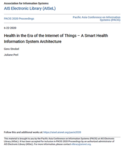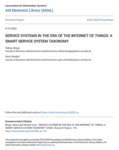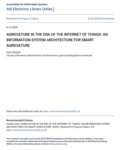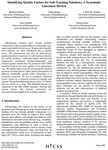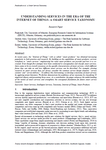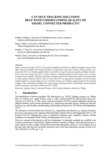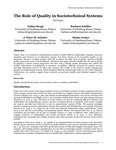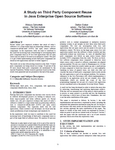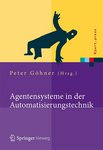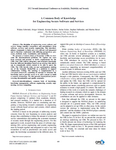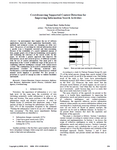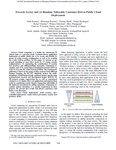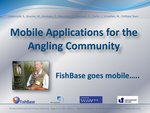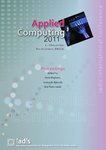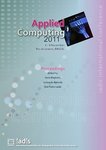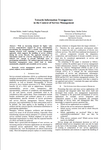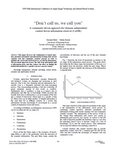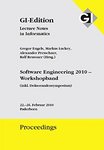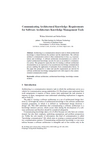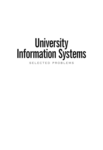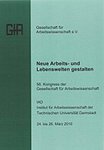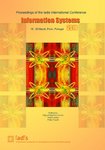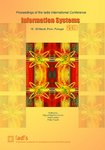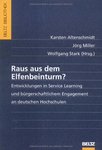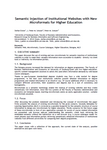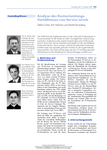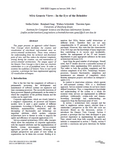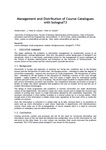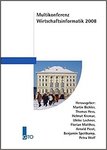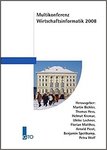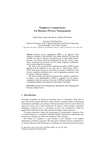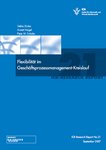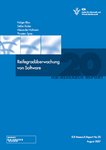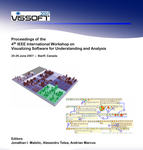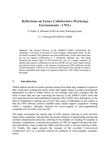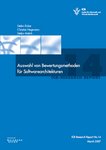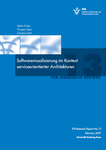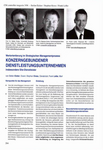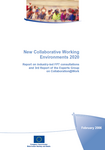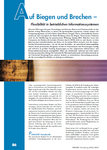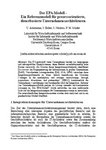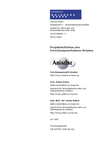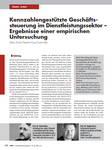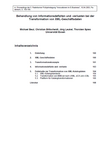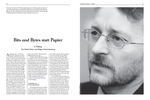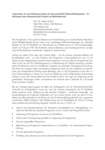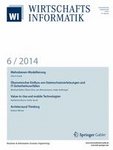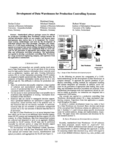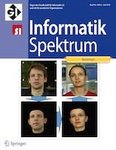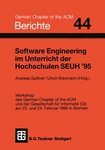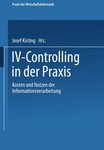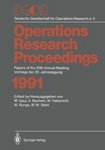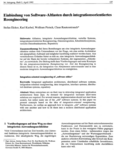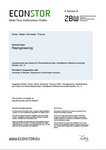Publications
- Banh, Leonardo; Rex, Alexander; Strobel, Gero; Urbach, Nils: Hiring Tomorrow's Talents: How Generative Artificial Intelligence Transforms Human Resources Recruitment. In: Proceedings of the 59th Hawaii International Conference on System Sciences (HICSS). Maui, Hawaii, USA, 2026. AbstractDetailsCitation
The global talent shortage has become a universal challenge, prompting practitioners and researchers to explore digital innovations as potential solutions for acquiring the right talents. However, the role of emerging technologies like generative artificial intelligence (AI) in human resources (HR) remains largely uncharted territory. This article investigates generative AI's transformative potential to augment recruiters' daily operations. Through a qualitative interview study, we derive and illuminate the opportunities of generative AI within the recruitment domain, shedding light on its promising opportunities but also addressing inherent challenges. The findings of this study propose a theoretical model of generative AI in recruitment and how it empowers recruiters in their daily tasks to recruit tomorrow's talents.
- Holldack, Florian; Banh, Leonardo; Strobel, Gero: Synthetic Conversations, Real Insights: Towards Realistic User Simulations with Generative Agents. In: Ais (Ed.): Proceedings of the 46th International Conference on Information Systems (ICIS). Nashville, Tennessee, USA, 2025. AbstractDetailsFull textCitation
The rise of generative AI and large language models (LLMs) has sparked interest in applying generative agents to simulate users in conversational recommender system (CRS) evaluations. While CRS rely on user perception for success, traditional user studies are costly and time-intensive. Existing simulation approaches lack interaction depth and user-centric evaluation. This study addresses these gaps by leveraging LLM-based generative agents to conduct scalable, subjective CRS assessments. We present a comparative study where 200 generative agents and 50 human participants interact with a prototypical agentic CRS and evaluate their experience using a structured questionnaire. Results indicate that generative agents approximate human-like behavior and subjective assessments at the macro-level, despite granular precision limitations, offering an alternative to traditional user studies. Our findings advance research on CRS evaluation by demonstrating how agentic simulations can support human-aligned assessments of socio-technical systems and open new avenues for applying Generative AI in user-centered decision support.
- Banh, Leonardo; Tran, Tuan Khang; Strobel, Gero: An Affordance Perspective on Generative AI in Enterprise Architecture. In: IEEE Access, Vol13 (2025), p. 192711-192730. doi:10.1109/ACCESS.2025.3631323AbstractDetailsCitation
Generative artificial intelligence (GenAI) has emerged as a transformative technology capable of creating novel content across multiple formats. Its rapid advancement fuels innovations and implications for various fields, including the unexplored domain of enterprise architecture. This study investigates the potential applications of generative AI in enterprise architecture through semi-structured expert interviews, analyzed using the theoretical lens of affordance theory. The research identifies four key affordances that generative AI offers enterprise architects: information research and synthesis, text generation and refinement, insight generation and decision support, and architectural content creation. The findings reveal that generative AI functions as a collaborative partner for enterprise architects, providing information and inspiration that, when combined with professional knowledge and expertise, enables the creation of high-quality and innovative enterprise architecture content. This technology shows promise in enhancing productivity, efficiency, and effectiveness in enterprise architecture practices.
- Banh, Leonardo: Developing a Generative AI Maturity Model for Supporting the Organizational Adoption Journey. In: Ais (Ed.): Wirtschaftsinformatik 2025 Proceedings. Münster, Germany, 2025. DetailsCitation
- Laufer, Jan; Banh, Leonardo; Strobel, Gero: Bridging Mind and Matter: A Taxonomy of Embodied Generative AI. In: Ais (Ed.): Wirtschaftsinformatik 2025 Proceedings. Münster, Germany, 2025. DetailsCitation
- Möllmann, Ben; Banh, Leonardo; Laufer, Jan; Strobel, Gero: Trust Me, I’m a Tax Advisor: Influencing Factors for Adopting Generative AI Assistants in Tax Law. In: AiS (Ed.): Wirtschaftsinformatik 2025 Proceedings. Münster, Germany, 2025. DetailsCitation
- Paeplow, Johanna; Schoormann, Thorsten; Möller, Frederik; Strobel, Gero: AI startups for good: A taxonomy and archetypes of sustainable business models. In: Journal of Cleaner Production, Vol520 (2025). doi:10.1016/j.jclepro.2025.146144AbstractDetailsCitation
Artificial Intelligence (AI) empowers startups to have a positive impact on personal and professional lives. Given that power, research on how business models utilize AI to contribute to sustainability is needed. Knowledge about various design options can help business model developers minimize unnecessary efforts and mitigate potential risks. This paper addresses this issue through twofold contributions: First, we provide a taxonomy of AI startup business models for good. Based on the analysis of 100 real-world instances, the taxonomy captures how AI is currently used in startups to achieve sustainability value. This helps scholars and practitioners be aware of and navigate key characteristics of such business models, as well as understand the boundaries of the overarching design solution space. Second, we present five archetypical configurations: AI environmental analyser, AI healthcare improver with patient data, AI product manufacturer for farming and grocery, AI surveillant and reporter of customer-provided data, and AI Energy Improver. These archetypes reflect common business model characteristic combinations that practitioners can use to develop or redesign their businesses. Researchers can further examine these archetypes to generate new insights, for instance, by evaluating their success and contributions to sustainable development.
- Chrarid, Soufian; Holldack, Florian; Woroch, Robert; Strobel, Gero: Developing Design Principles for VR Training Systems in Industrial Assembly and Maintenance. In: AiS (Ed.): 31st Americas Conference on Information Systems, AMCIS 2025. Montreal, Canada, 2025. DetailsCitation
- Banh, Leonardo; Stangl, Fabian J.; Strobel, Gero; Riedl, René: Exploring the NeuroIS Potential for Generative Artificial Intelligence: Findings from a Literature Review. In: Davis, Fred D.; Riedl, René; vom Brocke, Jan; Léger, Pierre-Majorique; Randolph, Adriane B.; Müller-Putz, Gernot R. (Ed.): Information Systems and Neuroscience NeuroIS Retreat 2025, Vienna, Austria. Springer, Cham, 2025. DetailsCitation
- Banh, Leonardo; Stangl, Fabian J.; Strobel, Gero; Riedl, René: The Role of Generative Artificial Intelligence in the NeuroIS Research Process: Applications and Opportunities. In: Davis, Fred D.; Riedl, René; vom Brocke, Jan; Léger, Pierre-Majorique; Randolph, Adriane B.; Müller-Putz, Gernot R. (Ed.): Information Systems and Neuroscience NeuroIS Retreat 2025, Vienna, Austria. Springer, Cham, 2025. DetailsCitation
- Banh, Leonardo; Strobel, Gero: The Sound of Progress: Investigating the Representation of Artificial Intelligence in Music. In: Beverungen, D.; Lehrer, C.; Trier, M. (Ed.): Conceptualizing Digital Responsibility for the Information Age. WI 2023. Lecture Notes in Information Systems and Organisation. Springer, Cham, 2025, p. 169-178. doi:10.1007/978-3-031-80119-8_11AbstractDetailsCitation
The role of artificial intelligence in daily life is constantly advancing and has become an important topic of discussion. With music and its lyrics being a vehicle to express topics of society, this paper investigates how artificial intelligence is perceived by musicians and reflected in their songs. By analyzing the lyrics of over 1200 songs over three decades, this work applies sentiment analysis to extract polarities and emotions. The results provide insights into how musicians view and reflect the impact of artificial intelligence on society and how this is reflected in their song texts. The findings show an increase in songs mentioning artificial intelligence-related terms, with a trend of more songs implying negativity, such as anger. However, minor increases in positive emotions indicate musicians’ ambivalent views on hopes and fear of artificial intelligence.
- Banh, Leonardo; Holldack, Florian; Strobel, Gero: Copiloting the Future: How Generative AI Transforms Software Engineering. In: Information and Software Technology, Vol183 (2025), p. 107751. doi:10.1016/j.infsof.2025.107751AbstractDetailsCitation
Context
With rapid technological advancements, artificial intelligence (AI) has become integral to various sectors. Generative AI (GenAI) tools like ChatGPT or GitHub Copilot, with their unique content creation capabilities, pose transformative potential in Software Engineering by offering new ways to optimize software development processes. However, the integration into current processes also presents challenges that require a sociotechnical analysis to effectively realize GenAI's potential.
Objective
This study investigates how GenAI can be leveraged in the domain of Software Engineering, exploring its action potentials and challenges to help businesses and developers optimize the adoption of this technology in their workflows.
Method
We performed a qualitative study and collected data from expert interviews with eighteen professionals working in Software Engineering-related roles. Data analysis followed the principles of Grounded Theory to analyze how GenAI supports developers' goals, aligns with organizational practices, and facilitates integration into existing routines.
Results
The findings demonstrate several opportunities of GenAI in Software Engineering to increase productivity in development teams. However, several key barriers were also identified, that should be accounted for in successful integrations. We synthesize the results in a grounded conceptual framework for GenAI adoption in Software Engineering.
Conclusions
This study contributes to the discourse on GenAI in Software Engineering by providing a conceptual framework that aids in understanding the opportunities and challenges of GenAI. It offers practical guidelines for businesses and developers to enhance GenAI integration and lays the groundwork for future research on its impact in software development.
- Eicker, Stefan; Woroch, Robert; Strobel, Gero: Wertgenerierung in Plattformökonomien und Determinanten zur Werteerstellung und -erfassung - Festschrift für Prof. Dr. Stephan Zelewski. In: Schütte, Reinhard; Hohmann, Susanne; Krol, Bianca; Peters, Malte L. (Ed.): Produktions- und Informationsmanagement. Springer Gabler, Wiesbaden, 2024, p. 505-531. doi:10.1007/978-3-658-46113-3_20AbstractDetailsFull textCitation
Digitale Plattformen haben sich dank ihres disruptiven Potenzials als führende Geschäftsmodelle in einer Vielzahl von Branchen etabliert. Dieser Beitrag beleuchtet die Entwicklung der Ökosystem-Metapher von ihren Ursprüngen bis zu ihrer Anpassung an den digitalen Wandel und diskutiert drei unterschiedliche Perspektiven auf moderne Unternehmensökosysteme. Darüber hinaus werden zentrale Treiber der Wertschöpfung in der Plattformökonomie vorgestellt, die als Instrumente zur Steuerung der Wertgenerierung dienen. Abschließend wird ein Ausblick auf zukünftige Forschungsfelder zur Wertschöpfung in plattformbasierten Ökosystemen gegeben.
Digital platforms have emerged as leading business models across a wide range of industries due to their disruptive potential. This article examines the development of the ecosystem metaphor from its origins to its adaptation to digital change and discusses three different perspectives on modern business ecosystems. In addition, key drivers of value creation in the platform economy are presented, which serve as instruments for managing value generation. The article concludes with an outlook on future fields of research on value creation in platform-based ecosystems.
- Strunk, Jobin Alexander; Banh, Leonardo; Nissen, Anika; Strobel, Gero; Smolnik, Stefan: To Delegate or Not to Delegate? Factors Influencing Human-Agentic IS Interaction. In: AiS (Ed.): Proceedings of the 45th International Conference on Information Systems (ICIS). Bangkok, Thailand, 2024. AbstractDetailsFull textCitation
The evolution of information systems (IS) in recent years, driven by advancements such as AI-based digital assistants and autonomous vehicles, has fundamentally changed human-IS interaction. This transformation extends beyond mere user interaction to encompass the emergence of agentic IS, challenging traditional notions of human supervision. It prompts a reevaluation of IS research, with a focus on IS delegation as a new theoretical lens. However, research remains nascent, particularly in understanding the factors influencing delegation decisions. We compiled 26 articles and derived six key delegation mechanisms and their influencing factors, using grounded theory and co-occurrence analysis. We investigate attributes of human and the agentic IS, as well as task attributes and the delegation level that are relevant to the delegation mechanisms. Our research provides a nuanced understanding of factors influencing delegation decisions to agentic IS. We call for research considering the yet underrepresented but crucial interdependencies with a research agenda.
- Wulfert, Tobias; Woroch, Robert; Strobel, Gero; Schoormann, Thorsten; Banh, Leonardo: E-commerce ecosystems as catalysts for sustainability: A multi-case analysis. In: Electronic Markets, Vol34 (2024), No 58. doi:10.1007/s12525-024-00733-zAbstractDetailsCitation
Single organizations encounter intricate challenges in meeting the UN’s Sustainable Development Goals (SDGs) on their own and thus are increasingly concerned with forming ecosystems. This is also the case in the e-commerce domain. It is assumed that particularly focal actors of such ecosystems have the power to foster initiatives towards more sustainability. We conducted an embedded multi-case study with 135 initiatives collected from three types of e-commerce ecosystems to uncover what sustainability goals are addressed by different ecosystem participants. This paper’s analysis explores (1) what sustainability initiatives are reported from focal actors and differences depending on a specific type of ecosystem, (2) dependencies between SDGs within the initiatives, and (3) the degree of involvement of other ecosystem actors and how they contribute to certain SDGs. Our work synthesizes existing initiatives towards sustainable development to give orientation and impulses for practice and academia as well as outlines avenues for future research at the intersection of ecosystems and sustainability.
- Metzger, Andreas; Laufer, Jan; Feit, Felix; Pohl, Klaus: A User Study on Explainable Online Reinforcement Learning for Adaptive Systems. In: ACM Trans. Auton. Adapt. Syst. (TAAS), Vol19 (2024), No 3. doi:10.1145/3666005AbstractDetailsCitation
Online reinforcement learning (RL) is increasingly used for realizing adaptive systems in the presence of design time uncertainty because Online RL can leverage data only available at run time. With Deep RL gaining interest, the learned knowledge is no longer represented explicitly but hidden in the parameterization of the underlying artificial neural network. For a human, it thus becomes practically impossible to understand the decision-making of Deep RL, which makes it difficult for (1) software engineers to perform debugging, (2) system providers to comply with relevant legal frameworks, and (3) system users to build trust. The explainable RL technique XRL-DINE, introduced in earlier work, provides insights into why certain decisions were made at important time steps. Here, we perform an empirical user study concerning XRL-DINE involving 73 software engineers split into treatment and control groups. The treatment group is given access to XRL-DINE, while the control group is not. We analyze (1) the participants’ performance in answering concrete questions related to the decision-making of Deep RL, (2) the participants’ self-assessed confidence in giving the right answers, (3) the perceived usefulness and ease of use of XRL-DINE, and (4) the concrete usage of the XRL-DINE dashboard.
- Wulfert, Tobias; Woroch, Robert; Strobel, Gero: Follow the flow: An exploratory multi-case study of value creation in e-commerce ecosystems. In: Information & Management, Vol61 (2024), No 8. doi:10.1016/j.im.2024.104035AbstractDetailsCitation
Platform-based ecosystems dominate e-commerce, generating value through participant growth and resulting network effects. However, research has lacked any conceptualization of value creation in e-commerce ecosystems. This paper fills this gap by providing a theoretically grounded and empirically validated conceptualization of value creation and exchange, including roles, value creation activities, and value flows among participants. The model integrates insights from a systematic literature review and a multi-case study of ten leading e-commerce ecosystems. Furthermore, an extension to the e3-value notation is proposed by introducing ecosystem segments, allowing for a higher level of abstraction of meta-roles and individual ecosystem participants.
- Banh, Leonardo; Strobel, Gero: Tourism in the Era of Internet of Things: Design Principles for Smart Tourism. In: Ais (Ed.): Wirtschaftsinformatik 2024 Proceedings. Würzburg, Germany, 2024. AbstractDetailsCitation
The tourism industry plays a crucial role in many countries and has suffered under the global events of the last years (e.g., COVID-19, economic recession) with a decline in visitors and economic contributions. Through digitalization efforts of cities and states, smart tourism destinations use emerging technologies like the Internet of Things and Smart Services to provide rich on-site experiences for visitors, hoping to increase their competitiveness and attract new tourists. By conducting a design science research project in collaboration with a German municipality, this paper aims to explore how digital assistants should be designed in the context of smart tourism. Based on expert interviews and a multi-case study of 37 tourism apps, we were able to develop twelve key design principles for smart tourism applications, evaluated through a prototypical instantiation, to create design knowledge for the digitalization of tourism.
- Strobel, Gero; Wulfert, Tobias; Banh, Leonardo: TWO SIDES OF THE SAME COIN: AN E-COMMERCE ECOSYSTEM AGENT-BASED SIMULATION. In: Ais (Ed.): Wirtschaftsinformatik 2024 Proceedings. Würzburg, Germany, 2024. AbstractDetailsCitation
E-commerce is one of the most important sectors of the economy, with an expected global turnover of USD 7.4 trillion in 2024. Leading companies in the industry like Amazon and Alibaba leverage platform business models that orchestrate complex ecosystems of buyers and sellers. These ecosystems are characterized by globally intertwined networks of independent participants and multifaceted interactions, making their development hard to predict. We propose an agent-based simulation approach, following the three-step process of Haki et al. (2020), to predict the behavior of e-commerce ecosystems with a particular focus on the impact of premium subscription services. Simulation models offer the opportunity to tangibly visualize the effects of a participant's actions on the ecosystem level. Our simulation includes the key actors (i.e., buyer, seller, marketplace), their characteristics, and behaviors to draw conclusions about the evolution of the ecosystem and the strategic role of premium memberships in shaping these digital landscapes.
- Opriel, Sebastian; Möller, Frederik; Strobel, Gero; Otto, Boris: Data Sovereignty in Inter-organizational Information Systems - Findings from Demand and Capacity Management in the Automotive Industry. In: Business & Information Systems Engineering (2024). doi:10.1007/s12599-024-00893-4AbstractDetailsCitation
Car manufacturers and suppliers in the Automotive industry increasingly face the issue of optimization of highly complex supply chains that need to accommodate each customer's precise demands, requiring a vast array of parts and information to be available at the right place and at the right time. This involves data sharing between organizations, which is hindered by various issues, such as fear of data misappropriation by the data receiver or the involuntary disclosure of business secrets. The paper proposes design principles for a novel type of Inter-Organizational Information System, which addresses these challenges through the technical implementation of data sovereignty. The study reports on an Action Design Research study in the Automotive industry between a car manufacturer and a 1st-tier supplier. It contributes (a) design requirements, (b) design features, (c) an instantiation, and (d) design principles for this type of data sovereign inter-organizational information system.
- Strobel, Gero; Banh, Leonardo: What Did the Doctor Say? Empowering Patient Comprehension with Generative AI. In: Ais (Ed.): ECIS 2024 Research Papers. Paphos, Cyprus, 2024. AbstractDetailsFull textCitation
As global challenges, such as pandemics, population growth and widespread illnesses, continue to rise, healthcare systems are facing greater strain, resulting in a shortage of resources and increased demands for medical care. Effective communication between healthcare professionals and patients is essential for the provision of good services to prevent confusion and induced anxiety of patients, particularly when medical jargon is employed and not understood. Generative AI (GAI) presents a chance to transform healthcare communication by providing language processing capabilities that enhance patient-centered services. This paper examines how GAI-based conversational agents for explaining medical jargon in healthcare should be designed. We derived eleven design principles from a systematic literature review and evaluated them with nine clinical cardiological scenarios through a prototypical instantiation of an LLM-based conversational agent. The results provide insights for researchers and healthcare providers in form of prescriptive design knowledge to improve patient communication using GAI.
- Schiller, Barbara: Konzeption eines Reifegradmodells zur ganzheitlichen Unterstützung der Entwicklung digitalisierter Produkte anhand der intendierten Produktreife (Dissertation). Essen 2024. doi:10.17185/duepublico/81975AbstractDetailsCitation
Der Forschungsbereich der digitalisierten Produkte (engl. smart products) ist vergleichsweise als jung und innovativ einzuordnen, weshalb die Forschung in dem Bereich bisher sehr heterogen und wenig holistisch ist und sich zudem auf etliche unterschiedliche Domänen verteilt. Als Folge fehlen zum einen oftmals fundierte Lösungen und zum anderen werden zahlreiche Herausforderungen in der Praxis nicht von der Forschung aufgegriffen. Erschwert wird die Situation zusätzlich einerseits durch eine fehlende einheitliche Terminologie und andererseits durch die immer häufiger stattfindende Erweiterung von digitalisierten Produkten zu umfangreichen Ökosystemen.
Das Ziel der vorliegenden Arbeit war daher die Konsolidierung des bisherigen Wissens über die Entwicklung digitalisierter Produkte aus den verschiedenen Anwendungs- und Forschungsdomänen zur Etablierung eines einheitlichen Body of Knowledges für die Forschung. Hierfür wurde ein domänenübergreifendes Reifegradmodell entwickelt und evaluiert, das Unternehmen bei der komplexen und von verschiedenen Herausforderungen tangierten Umsetzung unterschiedlicher Entwicklungsstufen der digitalisierten Produkte (z. B. Einzelprodukt, Produktsystem, System-of-Systems) unterstützt.
Durch das entwickelte, rasterbasierte Stufenmodell erhalten Unternehmen einerseits die Möglichkeit der Ist-Zustandsbewertung der im Unternehmen entwickelten digitalisierten Produkte und andererseits Zielvorgaben in Abhängigkeit zu der (zukünftig) angestrebten Produktentwicklungsstufe. Die Zielvorgaben decken dabei alle von der Entwicklung betroffenen Unternehmensbereiche ab, wie z. B. die Unternehmensstrategie, die Investitions- und Finanzierungsmöglichkeiten, die Unternehmensstruktur, die Unternehmensprozesse, die IT-Architektur oder das Stakeholder Management.
Die Entwicklung und Evaluation des Modells zeigte darüber hinaus sowohl Weiterentwicklungsmöglichkeiten des Modells als auch Ansätze zur Verbesserung der Reifegradmodellentwicklung im Allgemeinen auf. Dadurch konnte ein Beitrag zur Praxis und Forschung geleistet werden.
Research on smart products is still a young and innovative area of interest resulting in a heterogeneous and fragmented research field with many varying domains. Thus, well-grounded and comprehensive support for e.g., the development is often not available, while at the same time numerous challenges in practices and research are present. A missing consistent terminology and the advancement of smart products to large ecosystems complicates the situation even further.
Therefore, the goal of this research thesis was the consolidation of existing knowledge of different application and research areas about the development of smart products into a consistent body of knowledge. For this purpose, a research and application domain overarching maturity model was drafted, developed and evaluated. The model should support organizations with the complex and challenging development of different product maturity stages of smart products (e.g., smart product, product system, system-of-systems).
The resulting grid model allows for an (descriptive) as-is state assessment of the organizational smart products and provides the model users with improvement objectives in relation to the targeted product maturity stage. The objectives concern all organizational levels e.g., the strategy development, financial planning, organizational structure, organizational processes, IT architecture or stakeholder management.
Moreover, the model development and evaluation demonstrated potential for fur ther improvement of the developed model as well as the overall maturity model research. In doing so, contribution to practice and research of smart products and maturity model development in general could be achieved. - Wulfert, Tobias; Strobel, Gero; Hoang, Hiep: Let’s join forces: boundary resources as enablers of value co-creation in e-commerce ecosystems. In: Electronic Commerce Research and Applications (2024). doi:10.1007/s10660-024-09848-zAbstractDetailsCitation
Collaboration and value co-creation are important drivers of the continuous growth of e-commerce, which is expected to reach US \$6.4 trillion in 2024 despite current global crises. Only a few transaction platforms currently dominate e-commerce (eg., Amazon, Walmart), but other participants are likely to join these platforms’ ecosystems. Third-party developers can provide extensions to these ecosystems to enhance the platforms’ functionality, but third-party developers’ role in e-commerce ecosystems’ success and generativity remains underexamined in academia. The present study scrutinizes the efficacy of boundary resources in attracting and managing third-party developers in e-commerce ecosystems. This investigation is predicated upon qualitative data gathered through interviews with 14 domain experts. The insights derived from these interviews have culminated in the formulation of seven design principles. These design principles are envisaged to serve as a guiding framework for owners of innovation and transaction platforms within the e-commerce sphere, facilitating the strategic deployment of boundary resources. It is anticipated that collaboration, value creation, and the overall generative capacity as well as the success of e-commerce ecosystems shall be considerably enhanced.
- Möller, F.; Strobel, G.; Schoormann, T.; Otto, B.; Cappello, C.; Legner, C. (Ed.): Special Issue on Designing Data Ecosystems: Foundations, Configurations and Value. Electronic Markets , 2024. DetailsCitation
- Strobel, Gero; Banh, Leonardo; Möller, Frederik; Schoormann, Thorsten: Exploring Generative Artificial Intelligence: A Taxonomy and Types. In: Proceedings of the 57th Hawaii International Conference on System Sciences (HICSS). Hawaii, USA, 2024. AbstractDetailsFull textCitation
Generative Artificial Intelligence (GAI) is a prevalent topic in recent research and business, seemingly taking the position of a disruptive technology that has the potential to significantly transform industries ranging from productivity (e.g., ChatGPT-4) to creativity (e.g., DALL-E). While the emerging scientific discussion on GAI covers a variety of fields and issues, such as privacy, accuracy, and application scenarios, this paper sheds light on the business side of GAI by investigating the morphologic nature of start-ups and incumbents leveraging GAI. Based on the structured analysis of 100 real-world instances, we report on a taxonomy of GAI applications and services that advances our practical understanding, strengthens the distinguishability, as well as adds clarity to the discourse of GAI potentials. We provide an initial framework and five types of GAI, namely Generator, Reimaginator, Synthesizer, Assistant, and Enabler, that are informed by the core characteristics of the technology paradigm.
- Banh, Leonardo; Strobel, Gero: Generative artificial intelligence. In: Electronic Markets, Vol33 (2023), No 63. doi:10.1007/s12525-023-00680-1AbstractDetailsCitation
Recent developments in the field of artificial intelligence (AI) have enabled new paradigms of machine processing, shifting from data-driven, discriminative AI tasks toward sophisticated, creative tasks through generative AI. Leveraging deep generative models, generative AI is capable of producing novel and realistic content across a broad spectrum (e.g., texts, images, or programming code) for various domains based on basic user prompts. In this article, we offer a comprehensive overview of the fundamentals of generative AI with its underpinning concepts and prospects. We provide a conceptual introduction to relevant terms and techniques, outline the inherent properties that constitute generative AI, and elaborate on the potentials and challenges. We underline the necessity for researchers and practitioners to comprehend the distinctive characteristics of generative artificial intelligence in order to harness its potential while mitigating its risks and to contribute to a principal understanding.
- Metzger, Andreas; Bartel, Jone; Laufer, Jan: An AI Chatbot for Explaining Deep Reinforcement Learning Decisions of Service-Oriented Systems. In: Monti, F.; Rinderle-Ma, S.; Ruiz Cortés, A.; Zheng, Z.; Mecella, M. (Ed.): International Conference on Service-Oriented Computing (ICSOC). Springer, 2023, p. 323-338. doi:10.1007/978-3-031-48421-6_22DetailsCitation
- Petrik, D.; Springer, V.; Strobel, G.; Möller, F.; Schoormann, T: Understanding Value-based Pricing for Industrial Internet of Things. In: Proceedings of the 44th International Conference on Information Systems (ICIS). Hyderabad, India , 2023. DetailsCitation
- Strobel, Gero; Schoormann, Thorsten; Banh, Leonardo; Möller, Frederik: Artificial Intelligence for Sign Language Translation – A Design Science Research Study. In: Communications of the Association for Information Systems, Vol53 (2023), No 3. doi:10.17705/1CAIS.05303AbstractDetailsFull textCitation
Although our digitalized society is able to foster social inclusion and integration, there are still numerous communities having unequal opportunities. This is also the case with deaf people. About 750,000 deaf people only in the European Union and over 4 million people in the United States face daily challenges in terms of communication and participation, such as in leisure activities but more importantly in emergencies too. To provide equal environments and allow people with hearing handicaps to communicate in their native language, this paper presents an AI-based sign language translator. We adopted a transformer neural network capable of analyzing over 500 data points from a person’s gestures and face to translate sign language into text. We have designed a machine learning pipeline that enables the translator to evolve, build new datasets, and train sign language recognition models. As proof of concept, we instantiated a sign language interpreter for an emergency call with over 200 phrases. The overall goal is to support people with hearing inabilities by enabling them to participate in economic, social, political, and cultural life.
- Muschkiet, Michel; Wulfert, Tobias; Woroch, Robert; Strobel, Gero; Banh, Leonardo: Unleashing the digital building bricks - A smart service taxonomy for retail. In: Electronic Markets, Vol2023 (2023), No 33. doi:10.1007/s12525-023-00666-zAbstractDetailsFull textCitation
The increasing online competition, associated changes in customer behaviors, and effects of the pandemic in recent years have led to increasing retail store closures. This development has given rise to a downward spiral in terms of a decreasing attractiveness of local shopping places and a further reduction of stores. Research has recognized that smart services can unleash the potential to compensate for the competitive disadvantages of physical retailers by combining tailored physical and digital offerings to enhance customer-oriented value creation. However, most approaches are limited to in-store services without addressing the wider shopping experience in retail surroundings. Therefore, this paper provides a classification framework for smart services in retail evaluated against 163 use cases, as well as six service archetypes. This work contributes to understanding relevant service design elements and proposes applying the idea of a holistic customer experience to service design in physical retail environments.
- Banh, Leonardo; Strobel, Gero: The Sound of Progress: Investigating the Representation of Artificial Intelligence in Music. In: AiS (Ed.): Wirtschaftsinformatik 2023 Proceedings. Paderborn, Germany, 2023. AbstractDetailsFull textCitation
The role of artificial intelligence in daily life is constantly advancing and has become an important topic of discussion. With music and its lyrics being a vehicle to express topics of society, this paper investigates how artificial intelligence is perceived by musicians and reflected in their songs. By analyzing the lyrics of over 1,200 songs over three decades, this work applies sentiment analysis to extract polarities and emotions. The results provide insights into how musicians view and reflect the impact of artificial intelligence on society and how this is reflected in their song texts. The findings show an increase in songs mentioning artificial intelligence-related terms, with a trend of more songs implying negativity, such as anger. However, minor increases in positive emotions indicate musicians' ambivalent views on hopes and fear of artificial intelligence.
- Helferich, A.; Petrik, D.; Strobel, G.; Peine, K. (Ed.): Proceedings of the 1st International Conference on Software Product Management. 2023. DetailsCitation
- Wulfert, Tobias; Woroch, Robert; Strobel, Gero; Schoormann, Thorsten; Banh, Leonardo: Unboxing the Role of E-Commerce Ecosystems to Address Grand Challenges. In: Ais (Ed.): ECIS 2023 Research Papers. Kristiansand, Norway, 2023. AbstractDetailsFull textCitation
The modern world is confronted with grand challenges, such as those codified by the United Nations’ Sustainable Development Goals. As single organizations are often not capable of addressing a broad set of goals on their own, they are increasingly concerned with creating ecosystems. This is also the case in the domain of e-commerce. Owners of focal platforms in e-commerce ecosystems have the power to implement sustainability initiatives and therefore need to be equipped with an overview of possible initiatives and actionable guidance. To unbox how e-commerce ecosystem participants consider sustainability, we conducted a multi-case study with 99 initiatives collected from sustainability reports. We found that (1) sustainability initiatives particularly focus on reducing inequality and managing climate change as well as (2) manufacturers, sellers, and service providers are the most involved ecosystem participants. Based on our findings, we (3) synthesized six categories of sustainability initiatives as measurements.
- Petrik, D.; Springer, V.; Strobel, G.; Möller, F.; Schoormann, T.: The Price is Right: Exploring Pricing of Digital Industrial Platforms. In: Information Systems Management (2023). doi:10.1080/10580530.2023.2223356DetailsCitation
- Schoormann, T.; Strobel, G.; Möller, F.; Petrik, D.; Zschech, P.: Artificial Intelligence for Sustainability—A Systematic Review of Information Systems Literature. In: Communications of the Association for Information Systems , Vol52 (2023), No 1. doi:10.17705/1CAIS.05209DetailsCitation
- Azkan, C.; Strobel, G.; Iggena, L.; Gelhaar, J.; Kreyenborg, A.: Barriers to the development of data-driven services: An ISM approach for SMEs. In: Proceedings of the 56th Hawaii International Conference on System Sciences (HICSS) . Hawaii, USA , 2023. DetailsCitation
- Woroch, Robert; Strobel, Gero; Wulfert, Tobias: Four Shades of Customer: How Value Flows in Fintech Ecosystems. In: AiS (Ed.): ICIS 2022 Proceedings. Copenhagen, Denmark, 2022. AbstractDetailsFull textCitation
The financial sector is undergoing a massive transformation, with new technology-driven players challenging established mechanisms and transforming the sector into a fast-moving market. With the gradual transition from a scale economy to a platform-driven network economy, enterprise networks are gaining strategic importance. Despite the growing interest in fintech’s, research has so far lacked a conceptualization of value creation in fintech ecosystems. Therefore, this research paper aims to analyze key players, value creation activities, and value streams based on the analysis of the business models of payment services, personal financial management, robo-advisory, peer-to-peer lending, trading, and cryptocurrency. We present a holistic value network for the fintech ecosystem based on structured literature review and analysis of 171 fintech companies. We were able to show that fintech platform orchestrates multiple market sides and that customers take four distinct roles at the center of the ecosystem when using fintech services.
- Möller, Frederik; Schoormann, Thorsten; Strobel, Gero; Hansen, Magnus Rotvit Perlt: Unveiling the Cloak: Kernel Theory Use in Design Science Research. In: AiS (Ed.): ICIS 2022 Proceedings. Copenhagen, Denmark, 2022. AbstractDetailsFull textCitation
Theory is an essential part of design research and helps us to explain what we see or guide what we design. In the paper, we shed light on how kernel theories are used in developing design principles in Design Science Research (DSR). We do this by reporting on a systematic literature review, from which we have extracted a set of six mechanisms to operationalize kernel theory. Each mechanism consists of an activity (e.g., “transform to” or “derive from”) and an application point (e.g., meta-requirements or design principles) representing wherein the chain of concepts the kernel theory was used. The paper reflects on what we have learned about the use of kernel theories and translates this into recommendations and issues for further research. We provide researchers with guidance to use kernel theories more efficiently and give a big picture of the possibilities of kernel theory operationalization.
- Smolka, Sven; Laufer, Jan; Mann, Zoltán Ádám; Pohl, Klaus: UMLsec4Edge: Extending UMLsec to model data-protection-compliant edge computing systems. In: 2022 48th Euromicro Conference on Software Engineering and Advanced Applications (SEAA). Gran Canaria, Spain, 2022, p. 418-425. doi:10.1109/SEAA56994.2022.00072DetailsCitation
- Zmiewski, Sascha Sven; Laufer, Jan; Mann, Zoltán Ádám: Automatic online quantification and prioritization of data protection risks. In: Proceedings of the 17th International Conference on Availability, Reliability and Security (ARES). Association for Computing Machinery (ACM), Vienna, Austria, 2022. doi:10.1145/3538969.3539005AbstractDetailsCitation
Data processing systems operate in increasingly dynamic environments, such as in cloud or edge computing. In such environments, changes at run time can result in the dynamic appearance of data protection vulnerabilities, i.e., configurations in which an attacker could gain unauthorized access to confidential data. An autonomous system can mitigate such vulnerabilities by means of automated self-adaptations. If there are several data protection vulnerabilities at the same time, the system has to decide which ones to address first. In other areas of cybersecurity, risk-based approaches have proven useful for prioritizing where to focus efforts for increasing security. Traditionally, risk assessment is a manual and time-consuming process. On the other hand, addressing run-time risks requires timely decision-making, which in turn necessitates automated risk assessment. In this paper, we propose a mathematical model for quantifying data protection risks at run time. This model accounts for the specific properties of data protection risks, such as the time it takes to exploit a data protection vulnerability and the damage caused by such exploitation. Using this risk quantification, our approach can make, in an automated process, sound decisions on prioritizing data protection vulnerabilities dynamically. Experimental results show that our risk prioritization method leads to a reduction of up to 15.8% in the damage caused by data protection vulnerabilities.
- Sieber; C.; Silva, Da; M.; Strobel; G.; Brogt; T.; Berkowitz; S.; Zembrot; L.: A Universal Approach to Command and Control Heterogeneous Autonomous Robots.. In: Digitalisierungs-, Universität Der Bundeswehr Hamburg: Forschungsaktivitäten Im Zentrum Für; Dtec. Bw, Technologieforschung Der Bundeswehr (Ed.): dtec.bw-Beiträge der Helmut-Schmidt-Universität. 2022. doi:10.24405/14522DetailsCitation
- Wulfert, Tobias; Woroch, Robert; Strobel, Gero; Seufert, Sarah; Mölller, Frederik: Developing design principles to standardize e-commerce ecosystems - A systematic literature review and multi-case study of boundary resources. In: Electronic Markets (2022). doi:10.1007/s12525-022-00558-8AbstractDetailsCitation
Platform ecosystems have captured a variety of markets, enabling coordination, transactions, and value co-creation between independent actors. A focal platform constitutes the central nexus of e-commerce ecosystems and fosters the interaction among ecosystem participants through their boundary resources. Standardizing these interfaces simplifies ecosystem entry for developers and increases the number of participants propelling the network effects, and thus the overall value of the ecosystem. Currently, there is a lack of prescriptive design knowledge guiding platform owners in designing successful e-commerce ecosystems. Addressing this issue, we followed a dual approach, reporting on a systematic literature review in which we identified design requirements and complemented these with a multiple-case study on selected e-commerce ecosystems. Aggregating the requirements resulted in six meta-requirements and 19 design principles that foster the standardization of focal e-commerce platforms. Our design principles simplify the development of complements and enable multi-homing for developers due to possible standardization across ecosystems.
- Lachner, Clemens; Laufer, Jan; Dustdar, Schahram; Pohl, Klaus: A Data Protection Focused Adaptation Engine for Distributed Video Analytics Pipelines. In: IEEE Access, Vol10 (2022), p. 68669-68685. doi:10.1109/ACCESS.2022.3185990DetailsCitation
- Strobel; G.; Möller; F.; der Valk, Van; H.: Healthcare in the Era of Digital Twins – Towards A Domain-Specific Taxonomy. In: Proceedings of the 30th European Conference on Information Systems (ECIS). Timisoara, Romania , 2022. DetailsCitation
- van der Valk, Hendrik; Strobel, Gero; Handrup, Stephanie; Hunker, Joachim; Tomczyk, Martin: Supply Chains in the Era of Digital Twins – A Review. In: Proceedings of the International Conference on Industry Sciences and Computer Sciences Innovation. Porto, Portugal, 2022. DetailsCitation
- Wache, Hendrik; Möller, Frederik; Schoormann, Thorsten; Strobel, Gero; Petrik, Dimitri: Exploring the Abstraction Levels of Design Principles: The Case of Chatbots. In: Proceedings of the 17th International Conference on Wirtschaftsinformatik (WI). Nürnberg, Germany , 2022. AbstractDetailsCitation
Formulating design principles is the primary mechanism to codify design knowledge which elevates its meaning to a general level and applicability. Although we can observe a great variety of abstraction levels in available design principles, spanning from more situated to more generic levels, there is only limited knowledge about the corresponding (dis-)advantages of using a certain level of abstraction. That is problematic because it hinders researchers in making informed decisions regarding the (intended) level of abstraction and practitioners in being oriented whether the principles are already contextualized or still require effort to apply them within their situation. Against this backdrop, this paper (1) explores different abstraction levels based on a sample of 69 design principles from the chatbot domain as well as (2) provides a preliminary positioning framework and lessons learned. We aim to complement methodological guidance and strengthen the principles' applicability, leading to knowledge reuse.
- Woroch, Robert; Strobel, Gero: Show me the Money: How to monetize data in data-driven business models?. In: Proceedings of the 17th International Conference on Wirtschaftsinformatik (WI). Nürnberg, Germany, 2022. AbstractDetailsCitation
Increasing digitization and the associated tremendous usage of technology have led to data of unprecedented quantity, variety, and speed, which is generated, processed, and required in almost all areas of industry and life. The value creation and capturing from data presents companies with numerous challenges, as they must create or adapt appropriate structures and processes. As a link between corporate strategy and business processes, business models are a suitable instrument for meeting these challenges. However, few research has been conducted focusing on data-based monetization in the context of data-driven business models so far. Based on a systematic literature review the paper identifies five key components and 23 characteristics of data-driven business models having crucial influence on data-based value creation and value capturing and thus on monetization. The components represent key factors for achieving commercial benefits from data and serve as guidance for exploring and designing suitable data-driven business models.
- Laufer, Jan; Mann, Zoltán Ádám; Metzger, Andreas: Modelling Data Protection in Fog Computing Systems using UMLsec and SysML-Sec. In: ACM IEEE International Conference on Model Driven Engineering Languages and Systems Companion (MODELS-C). Fukuoka, Japan, 2021, p. 777-786. doi:10.1109/models-c53483.2021.00124DetailsCitation
- Schoormann, Thorsten; Strobel, Gero; Möller, Frederik; Petrik, Dimitri: Achieving Sustainability with Artificial Intelligence - A Survey of Information Systems Research. In: AiS (Ed.): Proceedings of the 42nd International Conference on Information Systems (ICIS). Austin, Texas, 2021. AbstractDetailsFull textCitation
Understanding the role of Artificial Intelligence (AI) is crucial to contribute to sustainable development including the most fundamental challenges of our society, such as climate change, healthy lives, and inclusive economic growth. As Information Systems (IS) research has a great tradition of investigating how technology and methods can be employed to foster sustainability, this study follows widely accepted expectations that AI will boost this. Against this backdrop, the present study aims at revealing how and what purposes IS researchers use AI for sustainability. Based on a literature corpus of 95 articles, promising research in diverse fields has been found that underlines the great potential of IS in achieving economic, ecological, and social sustainability. In doing so, this study complements recent research streams on AI and sustainability from a IS perspective by providing a comprehensive overview of themes, topics, and clusters addressed within IS literature and discussing future avenues for research.
- Woroch, Robert; Strobel, Gero: Understanding Value Creation in Digital Companies – A Taxonomy of IoT-enabled Business Models. In: AiS (Ed.): Proceedings of the 29th European Conference on Information Systems (ECIS 2021). A Virtual AIS Conference, 2021. AbstractDetailsCitation
The spread of the Internet of Things offers companies the potential to exert a disruptive influence on existing market structures and entire domains. The shift from product to service orientation and the integration of the customer as a value co-creator makes the identification and development of value-adding, IoT-based offerings a central challenge. As a link between strategy and business processes, business models are a suitable tool to meet this challenge. However, present business models lack of consideration of IoT specific characteristics. Against this background we provide a taxonomy for the description of IoT-based business models based on systematic literature research. Furthermore, the taxonomy is applied to 103 business models, demonstrating its usefulness. We also provide insights into the design of business models within two domains. The taxonomy provides a tool for investigating busi-ness models, especially how IoT can be incorporated into them and also a conceptual basis for future research.
- Strobel, Gero: Honey, I Shrunk the Internet of Things: An Internet of Nano-Things Taxonomy. In: AiS (Ed.): Proceedings of the 29th European Conference on Information Systems (ECIS). A Virtual AIS Conference, 2021. AbstractDetailsCitation
Nanotechnology is no longer science fiction. For more than half a century, the manipulation of matter at the atomic level has been an integral part of the methodological framework of a wide range of disciplines, e.g., physics, chemistry, biology. The fusion of nanotechnological approaches with the paradigm of the Internet of Things led to the creation of a new type of smart, internet-connected objects on the nanoscale at the beginning of the last decade under the term Internet of Nano Things. Despite the growing interest in research and practice, however, there is a lack of a basic, methodologically sound classification of methodological approaches and concepts that not only names them, but also shows their characteristics and forms of expression in order to create a common understanding within the domain. To address this shortcoming, the paper presents a taxonomy for IoNT-based systems to provide a conceptual basis for future research.
- Strobel, Gero; Paukstadt, Ute; Becker, Jörg; Eicker, Stefan: Von smarten Produkten zu smarten Dienstleistungen und deren Auswirkung auf die Wertschöpfung. In: Meinhardt, S.; Wortmann, F. (Ed.): IoT – Best Practices. Edition HMD. Springer Vieweg, Wiesbaden, 2021, p. 255-244. doi:10.1007/978-3-658-32439-1_13AbstractDetailsCitation
Im Rahmen der Digitalisierung nehmen smarte Produkte und die darauf aufbauenden intelligenten Dienstleistungen einen immer größeren Platz sowohl im betrieblichen Kontext als auch im Endkundenbereich ein. Auslöser hierfür stellt vor allem die leistungsfähigere und kostengünstigere Hardware dar, welche es Unternehmen ermöglicht, zunehmend Produkte mit intelligenten und vernetzten Komponenten auszustatten. Diese smarten Produkte bieten Unternehmen und Kunden völlig neue Möglichkeiten zur Interaktion, bieten neue Mehrwerte und beeinflussen die unternehmerische Wertschöpfung an sich. Ziel dieses Beitrages ist es, einen Einstieg in das Themenfeld der smarten Produkte und Dienstleistungen zu geben und aufzuzeigen, welche Möglichkeiten diese für den Endnutzer und für Unternehmen eröffnen.
Unveränderter Original-Beitrag Strobel et al. (2019) Von smarten Produkten zu smarten Dienstleistungen und deren Auswirkung auf die Wertschöpfung, HMD – Praxis der Wirtschaftsinformatik 56, 494–513. https://doi.org/10.1365/s40702-019-00520-x
- Eicker, Stefan; Strobel, Gero; Brogt, Tobias: Smart Service. In: Kollmann, T.; Kuckertz, A.; Stöckmann, C. (Ed.): Gabler Kompakt-Lexikon Unternehmensgründung. 3rd Edition. Springer Gabler, Wiesbaden, 2021. doi:10.1007/978-3-658-30901-5_19DetailsCitation
- Eicker, Stefan; Strobel, Gero: Backend as a Service (BaaS). In: Kollmann, T.; Kuckertz, A.; Stöckmann, C. (Ed.): Gabler Kompakt-Lexikon Unternehmensgründung. 3rd Edition. Springer Gabler, Wiesbaden, 2021. doi:10.1007/978-3-658-30901-5_2DetailsCitation
- Eicker, Stefan; Brogt, Tobias; Strobel, Gero: Smart Product. In: Kollmann, T.; Kuckertz, A.; Stöckmann, C. (Ed.): Gabler Kompakt-Lexikon Unternehmensgründung. 3rd Edition. Springer Gabler, Wiesbaden, 2021. doi:10.1007/978-3-658-30901-5_19DetailsCitation
- Strobel, Gero: Health in the Era of the Internet of Things: A Domain-Specific Modelling Language. In: Proceedings of the 54th Hawaii International Conference on System Sciences (HICSS). Hawaii, USA (Virtuell), 2021. AbstractDetailsCitation
Based on the cultural, social and technological development of the last hundred years, the pursuit of health driven by primal instincts has been transformed in most areas worldwide into a quasi de facto standard. But this security is deceptive. Not only the global developments of the last few months, but also creeping factors such as demographic change or the steadily growing world population are putting increasing pressure on the healthcare system. Today, more and more health care systems based on continuous demand for medical resources are increasingly reaching their limits. Technologies such as the Internet of Things are not a panacea, but offer great potential for increasing the flexibility and efficiency of healthcare systems. However, the development of such IoT-based healthcare systems requires a holistic understanding of the information technology as well as the domain itself. Against this background, the paper presents a domain-specific modelling language for IoT-based healthcare systems
- Strobel, Gero; Mittnacht, Judith: Richard, Are We There Yet? An Internet of Nano Things Information System Architecture. In: Proceedings of the 54th Hawaii International Conference on System Sciences (HICSS). Hawaii, USA (Virtuell), 2021. AbstractDetailsCitation
Richard Feynman’s visionary lecture at Caltech, which dates back more than half a century, is regarded as the birth of today's nanotechnology. Over time, many nanotechnology-based approaches, methods, and innovations have been adopted in almost all research disciplines. This nano-centered evolution is currently transforming the traditional paradigm of the Internet of Things into the Internet of Nano Things. However, the focus here is not on the mere adaptation of down scaling and is instead primarily on the effects and characteristics that result from this new scale. To fully exploit these new possibilities and combine them with existing added-value technologies, it is not sufficient to miniaturize existing Internet-of-Things- based systems—they must be developed from scratch. Against this background, this study examines the main areas of nanotechnology in combination with the Internet of Things phenomenon and, based on an exploratory literature search, presents an information system architecture for IoNT-based information systems.
- Strobel, Gero: Information Systems in the Era of the Internet of Things: A Domain-Specific Modeling Language. In: Proceedings of the 54th Hawaii International Conference on System Sciences (HICSS). Hawaii, USA (Virtuell), 2021. AbstractDetailsCitation
Based on the technological developments of the last few years and the associated digitalisation, the Internet of Things is now an essential part of practically every aspect of life. Smart products with their sensors and actuators are not only boundary objects between the physical and digital world, but also tie both worlds more and more together. The capabilities of the products range from simple monitoring tasks by drones in agriculture to autonomous use in mining. However, in order to exploit the full potential of these capabilities, it is not enough to use individual smart products or sensors, it is necessary to develop holistic IoT-based information systems from the ground up. To take such a systemic perspective, it is essential to have a sound conceptual understanding of the domain and a common language. Against this background, the publication presents a domain-specific modelling language for IoT-based information systems.
- Mann, Zoltán Ádám; Kunz, Florian; Laufer, Jan; Bellendorf, Julian; Metzger, Andreas; Pohl, Klaus: RADAR: Data Protection in Cloud-Based Computer Systems at Run Time. In: IEEE Access, Vol9 (2021), p. 70816-70842. doi:10.1109/ACCESS.2021.3078059DetailsCitation
- Loose, Nils; Thommessen, Christian; Mehlich, Jan; Derksen, Christian; Eicker, Stefan: Unified Energy Agents for Combined District Heating and Electrical Network Simulation. In: Sustainability, Vol12 (2020), No 21, p. 9301. doi:10.3390/su12219301AbstractDetailsCitation
A sustainable and climate-friendly energy supply needs flexible and efficient distribution systems. Key factors to implement this kind of systems are intelligent coordination (smart grid approaches) and the integration of different energy sectors. This article introduces the unified energy agent as an agent-based approach for a comprehensive modelling and control of energy conversion systems. This approach enables both the simulation and optimization of coupled energy networks, and then in a next step, the development of corresponding smart grid solutions to be applied in the field. Its applicability for the simulation of coupled networks is presented by a real-world use-case of an innovative combined heat and electrical network, which was implemented for the city of Lemgo, Germany. Preliminary results from the project are discussed and an outlook on future work is given.
- Strobel, Gero; Perl, Juliane: Health in the Era of the Internet of Things – A Smart Health Information System Architecture. In: AiS (Ed.): Proceedings of the 24th Pacific Asia Conference on Information Systems (PACIS). Dubai, UAE, 2020. AbstractDetailsFull textCitation
Health and well-being have been among the essential needs of humanity since the beginning of time. The healthcare systems are coming under more and more pressure due to a constantly growing world population, demographic change and steady rising of chronic disease rates. Through these circumstances, traditional healthcare systems may soon reach their limits and medical resources are becoming an increasingly valuable commodity. Modern technologies like the Internet of Things offer based on their application possibilities great potential for increasing among others flexibility, efficiency and cost-effectiveness of the healthcare system. To ensure such an IoT based healthcare for patients, holistic information and communication technology solutions are required that integrate both system-relevant technological and human aspects. Against this background, we present a generic information system architecture for smart health systems, based on a systematic literature driven explorative analysis of the domain.
- Brogt, Tobias; Strobel, Gero: Service Systems in the Era of the Internet of Things: A Smart Service System Taxonomy. In: AiS (Ed.): Proceedings of the 28th European Conference on Information Systems (ECIS). Marrakesh, Morocco, 2020. AbstractDetailsCitation
Services are becoming increasingly important, and service systems are seeing the use of service-dominant logic to understand value creation through the integration of active and passive resources. Digital transformation is significantly influencing service systems, and new, smart technologies are enabling innovative value propositions, leading to smart service systems. Smart products, which are a part of the Internet of Things, are the main building blocks of such systems. Attempts have been made to conceptualize smart service systems, but there seems to be no consensus in the literature because, for example, smart products have not been defined in a consistent way. We therefore examine ways to classify smart service systems in terms of their characteristics and attributes. We develop a taxonomy based on a systematic literature review focusing on smart features. Furthermore, an evaluation using domain-specific use cases demonstrates the applicability of the taxonomy. Our contribution combines and extends the available conceptualizations regarding smart service systems to pave the way for the necessary future research.
- Strobel, Gero: Agriculture in the Era of the Internet of Things: An Information System Architecture for Smart Agriculture. In: AiS (Ed.): Proceedings of the 28th European Conference on Information Systems (ECIS). Marrakesh, Morocco, 2020. AbstractDetailsCitation
Food has been a fundamental human need since the beginning of time. Agriculture, as the central foundation of global food production, is increasingly coming under pressure from the growing world population. Even today, it´s no longer possible to guarantee sufficient food security in the long term and 10% of humanity goes to bed hungry every night. Given the expected increase in the world’s population based on today’s figures and an associated more than 70% necessary increase in food sector production, the question arises whether this is feasible using classical methods and approaches. The use of modern information and communication technology alone is certainly not a panacea. Despite all this, technologies, such as the Internet of Things, show great potential for the development of more productive and cost-effective but, above all, more sustainable agriculture. However, developing such a solution requires more than a purely technical point of view. Only by creating a holistic information technology solution that takes not only a technological but also a plant, animal, human and therefore holistic perspective can real progress be made. Against this background, this paper represents the publication of a generic information system architecture based on a systematic literature-driven explorative analysis of the domain.
- Jonasson, Maurizio; Brogt, Tobias: Entwicklung eines Konzepts zur informationssystembasierten Unterstützung intermodaler Mobilitätsansätze. In: Proff, Heike (Ed.): Neue Dimensionen der Mobilität. Springer Gabler, Wiesbaden, 2020, p. 515-532. doi:10.1007/978-3-658-29746-6_42DetailsFull textCitation
- Strobel, Gero: Farming in the Era of Internet of Things - An information system architecture for smart farming. In: Proceeding of the 15th International Conference on Wirtschaftsinformatik (WI). 15th Edition. Potsdam, 2020. doi:10.30844/wi_2020_x1-strobelAbstractDetailsFull textCitation
The Internet of Things and associated smart products are finding application in evermore domains. Within agriculture it is described under the term smart farming. Using smart products allows farmers to automatically record relevant information, monitor operating procedures or remotely control machines. To make these capabilities usable for added value, not only smart products but entire information systems that align to the domain and its requirements are necessary. Within the literature, various architectures can be found already. However, many lack a methodical foundation or an abstraction of application cases and technology. Against this background, the article presents an information system architecture independent of application cases or technology and oriented toward the domain of smart farming. Starting point of the development is a systematic literature review, based on Webster and Watson in combination with Vom Brocke, based on 18 existing architecture approaches that are analyzed and aggregated.
- Schiller, Barbara; Brogt, Tobias; Schuler, J. Peter M.; Strobel, Gero; Eicker, Stefan: Identifying Quality Factors for Self-Tracking Solutions: A Systematic Literature Review. In: Proceedings of the 53nd Hawaii International Conference on System Sciences. Hawaii, USA, 2020. doi:10.24251/HICSS.2020.452AbstractDetailsCitation
Self-tracking solutions have become globally widespread, as they promise numerous advantages (e.g. improving health) to their users. Despite their benefits, such solutions are often abandoned due to quality issues. This phenomenon can also be observed for digitized products in general. As self-tracking solutions are hybrid products, combining digital and physical components, traditional domain-independent and abstract quality models like the prominent ISO 25000 standard seem to not cover quality in an appropriate way. We address these issues by answering the research question of which factors affect quality perceptions of different stakeholder groups when interacting in a wearable ecosystem. We use a systematic literature review based on a research protocol to identify and analyze 98 quality-influencing factors from 19 studies that we cluster in a map. The identified factors are compared to the ISO 25000 standard, showing that certain factors like hedonic motivation are unconsidered thoroughly in the existing standard.
- Thörmer, Falk; Hein, Markus; Strobel, Gero; Eicker, Stefan: Die gewerbesteuerliche Hinzurechnung von Aufwendungen für Infrastructure as a Service (IaaS). In: Betriebs Berater , Vol2019 (2019), No 50, p. 2967-2970 (ISSN: 0340-7918). AbstractDetailsFull textCitation
Die Bedeutung von sog. Cloud-Services hat in den vergangenen Jahren deutlich zugenommen. Hiermit einher gehen unterschiedlichste Zweifelsfragen und Auseinandersetzungen mit der Finanzverwaltung im Rahmen von Betriebsprüfungen. Dies ist der Tatsache geschuldet, dass regelmäßig große Unsicherheit auf drei Ebenen besteht: Es ist erstens für die Steuerabteilung oder den Berater nur schwer nachvollziehbar, welche konkreten Leistungen sich hinter einem Begriff wie “Cloud-Aufwendungen” verbergen und wie diese Leistungen technisch erbracht werden. Auf einer zweiten Ebene herrscht regelmäßig Unsicherheit im Hinblick auf die zivilrechtliche Kategorisierung entsprechender Verträge und Leistungsbeziehungen. Schließlich ist auf einer dritten Ebene regelmäßig unklar, wie sich die steuerliche Behandlung darstellt. Das kann unter anderem Themen wie Quellensteuereinbehalt/beschränkte Steuerpflicht, die Hinzurechnungsbesteuerung oder auch die gewerbesteuerliche Hinzurechnung betreffen. Der vorliegende Beitrag widmet sich letzterer und hierbei insbesondere der sog. Infrastructure as a Service (IaaS) als einer wesentlichen Art von Cloud-Diensten.
- Ludwig, Marcel; Mehlich, Jan; Azad, Schaugar; Zdrallek, Markus; Thommessen, Christian; Witte, Nicolas; Loose, Nils; Settertobulte, Ralf; Weber, Uwe: Development Of Cross-Sectoral Active Network Management Systems Using New Engineering Paradigms. In: Proceedings of 2019 IEEE PES 2019. 2019, p. 1-5. doi:10.1109/ISGTEurope.2019.8905516DetailsCitation
- Paukstadt, Ute; Strobel, Gero; Eicker, Stefan: UNDERSTANDING SERVICES IN THE ERA OF THE INTERNET OF THINGS: A SMART SERVICE TAXONOMY. In: Ais (Ed.): Proceedings of the 27th European Conference on Information Systems (ECIS). Stockholm, 2019. AbstractDetailsFull textCitation
In recent years, the “Internet of Things” with so called “smart products” has obtained increasingpopularity in both practice and research. By building on the capabilities of smart products, servicestransform to “smart services” emphasizing the value smart products can provide and how it is co- created. Even though first attempts have been conducted to conceptualize and classify smart services, there seems to be no overall consensus on the specific characteristics of smart services, which different forms they can take on and how different smart services can be described. For example, existing research on smart services does not always consider the common service design elements “servicecontent” and “service delivery”. To address this shortcoming, we develop a taxonomy of smart services by applying extant literature. We further demonstrate the usefulness of our taxonomy by classifying 50 empirical objects and presenting three cases. As a contribution, the paper enhances the understanding of the notion of smart services and strengthens the conceptual foundation for future smart service research.
- Brogt, Tobias; Eicker, Stefan: Einsatz von Servicesystemen zur Umsetzung von Innovationen im Kontext der Digitalisierung. In: Kollmann, Tobias (Ed.): Handbuch Digitale Wirtschaft. Springer Gabler, Wiesbaden, 2019. doi:10.1007/978-3-658-17345-6_82-1AbstractDetailsFull textCitation
Durch die Digitalisierung befinden sich Unternehmen oftmals in der Umstellung zu digitalen Geschäftsprozessen und Geschäftsmodellen. Dies bietet viele neue Chancen für Innovationen durch den Einsatz neuer Konzepte und Technologien. Um diese Chancen nutzbar zu machen, können Servicesysteme eingesetzt werden. Der Beitrag gibt einen Überblick über dieses Konzept und zeigt auf, wie Servicesysteme charakterisiert und entworfen werden können. Ein Servicesystem stellt ein soziotechnisches System dar, das auf die Unterstützung der gemeinsamen Wertschöpfung abzielt, indem verschiedene interne und externe Ressourcen integriert und kombiniert werden. Der Entwurf erfolgt im Rahmen des Service Systems Engineerings in meist agilen Prozessen mit dem Ziel einer frühen Markterprobung. Dabei kann der Innovationsgedanke explizit berücksichtigt werden. Vorhandene Entwurfsansätze sind jedoch meist abstrakt und daher weniger für den konkreten Entwurf geeignet. Es können daher wesentliche Faktoren identifiziert werden, die die Entwicklung von Servicesystemen beeinflussen. Der Beitrag schafft einen Überblick über den aktuellen Stand der Forschung und zeigt Ansatzpunkte für eine Verbesserung der Nutzbarmachung des Konzeptes Servicesystem.
- Strobel, Gero; Paukstadt, Ute; Becker, Jörg; Eicker, Stefan: Von smarten Produkten zu smarten Dienstleistungen und deren Auswirkung auf die Wertschöpfung. In: HMD Praxis der Wirtschaftsinformatik, Vol56 (2019), No 3, p. 494-513. doi:10.1365/s40702-019-00520-xAbstractDetailsFull textCitation
Im Rahmen der Digitalisierung nehmen smarte Produkte und die darauf aufbauenden intelligenten Dienstleistungen einen immer größeren Platz sowohl im betrieblichen Kontext als auch im Endkundenbereich ein. Auslöser hierfür stellt vor allem die leistungsfähigere und kostengünstigere Hardware dar, welche es Unternehmen ermöglicht, zunehmend Produkte mit intelligenten und vernetzten Komponenten auszustatten. Diese smarten Produkte bieten Unternehmen und Kunden völlig neue Möglichkeiten zur Interaktion, bieten neue Mehrwerte und beeinflussen die unternehmerische Wertschöpfung an sich. Ziel dieses Beitrages ist es, einen Einstieg in das Themenfeld der smarten Produkte und Dienstleistungen zu geben und aufzuzeigen, welche Möglichkeiten diese für den Endnutzer und für Unternehmen eröffnen.
- Paukstadt, Ute; Strobel, Gero; Eicker, Stefan; Becker, Jörg: Smart Services und ihr Einfluss auf die Wertschöpfung und Geschäftsmodelle von Unternehmen. In: Kollmann, Tobias (Ed.): Handbuch Digitale Wirtschaft. Springer Gabler, Wiesbaden, 2019, p. 1-21. doi:10.1007/978-3-658-17345-6AbstractDetailsFull textCitation
In den letzten Jahren wurde die Digitalisierung verstärkt vor dem Hintergrund desInternets der Dinge betrachtet, bei dem jegliche Bestandteile des täglichen Lebens zu intelligenten Objekten (Smart Products) werden und mit dem Internet verbunden sind. Aufbauend auf den Smart Products entstehen neue digitale Dienstleistungen, sogenannte Smart Services. Mit diesen intelligenten Dienstleis- tungen werden völlig neue Wertschöpfungspotenziale erschlossen, die sich eben- falls auf die Geschäftsmodelle von Unternehmen auswirken. Ziel dieses Beitrages ist es, einerseits einen allgemeinen Einstieg in den Themenkomplex der Smart Services zu bieten und selbige andererseits spezifisch vor dem Hintergrund ihres Wertschöpfungspotenzials für Geschäftsmodelle und Ökosysteme näher zu beleuchten.
- Schiller, Barbara; Brogt, Tobias; Schuler, J. Peter M.; Strobel, Gero: Can Self-Tracking Solutions Help with Understanding Quality of Smart, Connected Products?. In: Ais (Ed.): Proceedings of the 26th European Conference on Information Systems (ECIS). Portsmouth, 2018. AbstractDetailsCitation
Smart connected products (SCPs) have gained significant attention in different domains because they offer numerous benefits and change the way of competition and value creation. While quality is im-portant for SCPs, no holistic quality model is available to target the present quality problems. Further-more, since the concept of an SCP is quite abstract, a bottom-up approach that starts with a concrete example seems suitable. Therefore, this paper identifies the five key components of SCPs and maps them to self-tracking solutions (STS) in order to show that STSs are suitable substitutes. We also analyse quality models in corresponding areas to verify the absence of a holistic quality model for the selected example. This contribution identifies the research gap regarding holistic, stakeholder-oriented quality models and helps researchers understand SCPs better.
- Ludwig, Marcel; Korotkiewicz, Kamil; Dahlmann, Benedikt; Zdrallek, Markus: Agent-based Grid Automation in Distribution Grids: Experiences Under Real Field Conditions. In: Aim (Ed.): Proceedings of CIRED Workshop 2018 2018. 2018. doi:10.34890/315AbstractDetailsCitation
In this contribution, the experiences and results from the tests under real field conditions are described, which are concerned with grid automation systems in the research project Agent.HyGrid. Furthermore, the deployment of the grid automation system in a real-world distribution grid is discussed.
- Törsleff, Sebastian; Derksen, Christian; Wassermann, Erik; Fay, Alexander; Derksen, Christian; Loose, Nils: An Algorithm for the Temporary Acquisition of Control over Third Party Assets in Active Network Management. In: Conference on Sustainable Energy Supply and Energy Storage Systems . 2017. DetailsCitation
- Loose, Nils; Derksen, Christian; Unland, Rainer: Testbed Application of Energy Agents. In: Derksen, Christian; Weber, Christoph (Ed.): Smart Energy Research. At the Crossroads of Engineering, Economics, and Computer Science. 3rd and 4th IFIP TC 12 International Conferences, SmartER Europe 2016 and 2017, Essen, Germany, February 16-18, 2016, and February 9, 2017, Revised Selected Papers. 2017, p. 147-160. doi:10.1007/978-3-319-66553-5_11AbstractDetailsCitation
This work introduces the concept of testbed application of energy agents, which is the intermediate step between testing agents in pure simulation environment and deploying them in real energy distribution systems. In the testbed application case, the energy agent is taken from the simulation environment and deployed to dedicated hardware, where it controls a simulated or real technical system, while still working against a simulated environment. Compared to a pure simulation environment, this application case raises a number of new challenges, mainly resulting from inter-platform agent communication. In this work these challenges are discussed and an implementation handling them is presented and evaluated.
- Derksen, Christian; Weber, Christoph: Smart Energy Research. At the Crossroads of Engineering, Economics, and Computer Science - 3rd and 4th IFIP TC 12 International Conferences, SmartER Europe 2016 and 2017, Essen, Germany, February 16-18, 2016, and February 9, 2017, Revised Selected Papers. In: IFIP Advances in Information and Communication Technology. Springer International Publishing; Imprint; Springer, 2017. doi:10.1007/978-3-319-66553-5AbstractDetailsCitation
This volume consists of revised selected papers presented at the 3rd and 4th International Conference on Smart Energy Research, SmartER Europe 2016 and 2017, held in Essen, Germany, in February 2016 and 2017. The 13 full papers included in this volume were carefully reviewed and selected from 25 submissions. The papers discuss recent advances and experiences in building and using new IT-based solutions for Smart Grids and Smart Markets combining the knowledge of different disciplines such as engineering, business management and economics as well as computer science. They reflect the versatility and the complexity of the transformation process in the energy sector and also show the great need for research that is required to achieve the high targets for a digitized and sustainable energy landscape.
- Loose, Nils; Derksen, Christian; Unland, Rainer: Unified Energy Agents in Simulations, Testbeds and Real Systems. In: Proceedings of the Erasmus Energy Forum 2017. Rotterdam, 2017. DetailsCitation
- Brogt, Tobias; Schiller, Barbara; Schuler, J. Peter M.; Eicker, Stefan: The Role of Quality in Sociotechnical Systems. In: Ais (Ed.): Proceedings of AMCIS 2017 - Twenty-third Americas Conference on Information Systems. Boston, 2017. AbstractDetailsFull textCitation
Today, value is co-created in sociotechnical systems in which different stakeholders integrate resources (products and services) in an interactive process. For these systems to be successful, quality is very important. However, existing systems often fail to deliver the right level of quality, and the available quality approaches seem to be insufficient. Therefore, this paper provides insight into the role of quality by applying a service system perspective. We show that a holistic quality perception that reflects the modern expectations of stakeholders is necessary. In addition, different resources for modern services and their interaction need to be taken into account. This results in the need for quality management specific for sociotechnical systems, which integrates different existing approaches to cover these demands. Furthermore, the authors suggest future research on perceived quality and technical support in this context.
- Wassermann, Erik; Linnenberg, Tobias; Törsleff, Sebastian; Fay, Alexander; Derksen, Christian; Loose, Nils; Unland, Rainer; Ludwig, Marcel; Stötzel, Marcus; Zdrallek, Markus; Heldmaier, Wolfram: Einheitliches und durchgängiges Engineering von Steuerungslösungen für hybride Energiesysteme und -netze mittels Energie-Agenten. In: at - Automatisierungstechnik, Vol65 (2017), No 1, p. 60-72. DetailsCitation
- Törsleff, Sebastian; Derksen, Christian; Fay, Alexander; Heldmaier, Wolfram; Linnenberg, Tobias; Loose, Nils; Ludwig, Marcel; Stötzel, Marcus; Unland, Rainer; Wassermann, Erik; Zdrallek, Markus: Verteilte Automatisierung hybrider Energiesysteme. In: atp edition, Vol58 (2016), No 11, p. 55-64. DetailsCitation
- Derksen, Christian; Unland, Rainer: The EOM: An adaptive energy option, state and assessment model for open hybrid energy systems. In: Federated Conference on Computer 2016. 8th Edition. 2016, p. 1507-1515. doi:10.15439/2016F392AbstractDetailsCitation
The current transformation process of how energy is supplied attracts great interest from many different market players. As a consequence, many proprietary solutions for ``smart'' energy applications are flooding the market. This turns out to be rather a problem than part of the solution for the systematic development of future energy grids. Additionally, the absence of necessary standards blocks further developments that enable the creation of novel, market-driven and hybrid control solutions. To overcome these problems, we suggest a standardized control approach for hybrid energy systems by means of a so called Energy Option Model (EOM). This unifying model and the therewith developed decision support system provides the necessary technical understanding and the economic assessment options for network-connected energy conversion systems. Thus, it can be used for single on-site systems as well as for aggregated systems that are controlled in centralized or decentralized manner. This paper presents and discusses exemplary use cases for our EOM that illustrate the centralized as well as the decentralized use of our approach within hybrid energy systems. Overall, we believe that the EOM represents the key approach for a further systematic development of an open hybrid energy grid.
- Loose, Nils; Törsleff, Sebastian; Derksen, Christian; Unland, Rainer; Fay, Alexander: Hardware Integration and Real-Time Control in an Agent-Based Distribution Grid Simulation. In: Demazeau, Davidsson – Advances in Practical Applications (Ed.): International Conference on Practical Applications of Agents and Multi-Agent Systems. Springer, 2016, p. 329-332. doi:10.1007/978-3-319-59930-4_31AbstractDetailsCitation
In recent years, several developments in the energy sector have been imposing major challenges on our energy supply infrastructure. Due to the liberalization of the energy markets that started in the 1990s, longstanding monopolies are being broken up and new actors enter the stage. An increasing awareness regarding the environmental impacts of fossil fuel-based electricity generation put renewable energy sources like wind and solar on a lasting growth path. The volatility inherent to these sources and the shift from centralized to decentralized generation necessitate new approaches as to how energy is marketed, distributed and consumed. The smart grid, i.e. equipping the energy infrastructure with modern information and communication technology, is widely considered essential in addressing the challenges outlined.
- Loose, Nils; Nurdin, Yudha; Ghorbani, Sajad; Derksen, Christian; Unland, Rainer: Evaluation of Aggregated Systems in Smart Grids: An Example Use-Case for the Energy Option Model. In: Bajo, Escalona - Highlights of Practical Applications (Ed.): International Conference on Practical Applications of Agents and Multi-Agent Systems. Springer, 2016, p. 369-380. doi:10.1007/978-3-319-39387-2_31AbstractDetailsCitation
As a result of fast growing share of renewable energy production in the energy market the management of power and its distribution becomes more and more complex. The here presented Energy Option Model (EOM) seems to be a promising solution to handle this newly arisen complexity. This paper will present the EOM and analyze its capabilities in centralized evaluation of aggregated systems. The example use-case will be the charging process of a fleet of electric vehicles. While the results support the potential of the EOM to implement coordination strategies for aggregations of systems, they also show the general limitations of centralized control solutions for larger groups of systems in the context of smart grids.
- Linnenberg, Tobias; Wassermann, Erik; Fay, Alexander; Derksen, Christian; Unland, Rainer; Oerter, Christian; Ludwig, Marcel; Zdrallek, Markus; Heldmaier, Wolfram; Stiegler, Martin: Design, implementation and testing of multi-energy infrastructures the multi agent way in Agent.HyGrid. In: Ieee (Ed.): 2016 IEEE International Energy Conference 2016. 2016, p. 1-6. doi:10.1109/ENERGYCON.2016.7513918AbstractDetailsCitation
Adaptation models; Agent.HyGrid project; Computational modeling; Context; Control Engineering; decentralized decision making; electrical power; energy markets; future energy grids exhibit; hybrid hardware test-beds; hybrid power systems; hybrid software test-beds; multiagent systems; multi-agent systems; multienergy infrastructure testing; power engineering computing; power markets; program testing; Simulation; Software; software artifacts; software development processes; software reusability; Systematics; Testing
- Derksen, Christian; Linnenberg, Tobias; Neusel-Lange, Nils; Stiegler, Martin: Agent.HyGrid: A seamless Development Process for agent-based Control Solutions in hybrid Energy Infrastructures. In: Weber; 2015, Derksen - Proceedings SmartER Europe Conference (Ed.): Proceedings SmartER Europe Conference 2015. 2015, p. 17-24. DetailsCitation
- Weber, Christoph; Derksen, Christian: Proceedings SmartER Europe Conference 2015. In: Proceedings SmartER Europe Conference 2015. 2015. DetailsCitation
- Derksen, Christian; Linnenberg, Tobias; Unland, Rainer; Fay, Alexander: Structure and Classification of Unified Energy Agents as a base for the systematic development of Future. In: EAAI - Engineering Applications of Artificial Intelligence, Vol2015 (2015), No 41, p. 310-324. doi:10.1016/j.engappai.2014.10.005AbstractDetailsCitation
The ongoing conversion of our energy supply encounters a great interest of many different market players that were originally located in different industries. As a consequence, a vast amount of proprietary solutions for “smart” energy applications is flooding the market. This tends to be rather a problem than part of the solution for the systematic development of future energy grids. Here, the absence of necessary unifications and standards blocks further developments that would enable the creation of novel, market-driven and hybrid control solutions for various types of technical systems. To overcome these problems, we present in this article our notion and the definition of a unified autonomous software entity that we call Energy Agent. Based on the energy conservation law and a generalized energy option model, we claim that our Energy Agent approach has the capabilities to enable cross domain interactions between different types of energy systems and networks. Further we will outline a systematic development process for Energy Agents that considers implementation, simulation, test-bed application and a real on-site usage. By taking into account these development stages, we expect to concurrently develop a novel laboratory that enables to competitively test and validate new and hybrid control solutions before they are applied in real systems.
- Linnenberg, Tobias; Derksen, Christian; Fay, Alexander; Unland, Rainer: Cross-Domain Energy Savings by means of Unified Energy Agents - 14. In: Leitão, Karnouskos (Ed.): Industrial Agents. 2015, p. 247-268. doi:10.1016/B978-0-12-800341-1.00014-0AbstractDetailsCitation
This chapter presents a novel approach to dynamic resource allocation in hybrid energy grid scenarios, called energy-agents. This concept allows the easy control of inter-domain energy exchanges, such as heat generation from electricity or gas, the production of gas from electricity, or vice versa, based on the first law of thermodynamics. In a first hardware and software implementation, we were able to showcase the functionality and usability of this approach, enabling the developers of smart grid solutions to use the same code throughout the entire development process. This reusability will help to keep down development time and costs. On top of this, we were able to realize energy and cost savings by dynamically allocating the energy sources, as required by the consumer processes.
- Derksen, Christian; Linnenberg, Tobias; Unland, Rainer; Fay, Alexander: Unified Energy Agents as a Base for the Systematic Development of Future Energy Grids. In: Klusch, Thimm – Multiagent System Technologies (Ed.): 11th German Conference Proceedings. 11th Edition. 2013, p. 236-249. doi:10.1007/978-3-642-40776-5_21AbstractDetailsCitation
The need for the application of software agents and agent-technologies in highly diversified future energy grids is widely accepted today. Nevertheless, the very general concept of the agent paradigm still leads to misunderstandings and to the fact that agents are meant and utilized for very different tasks. Accordingly, the approaches that were presented in the Smart Gird area have major weaknesses in terms of comparability and a subsequently large-scale use. We claim that the introduction of a unified definition of an Energy Agent will help to create a coherent picture that can accelerate further discussions and the conversion of the energy supply. Considering a development cycle that consists of modeling and implementation, simulation, test-bed application and the deployment to real systems, we present here our definition of an Energy Agent that takes into account the law of conservation of energy. Further, we present a classification of Energy Agents according to their sophistication and integration level and outline the need for individual but standardized energetic option models.
- Schwittek, Widura; Eicker, Stefan: A study on third party component reuse in Java enterprise open source software. In: Kruchten, Philippe; Giannakopoulou, Dimitra; Tivoli, Massimo (Ed.): CBSE '13 Proceedings of the 16th International ACM Sigsoft symposium on Component-based software engineering. ACM, New York, NY, USA, 2013, p. 75-80. doi:10.1145/2465449.2465468AbstractDetailsFull textCitation
Recent studies give empirical evidence that much of today's software is to a large extent built on preexisting software, such as commercial-off-the-shelf (COTS) and open source software components. In this exploratory study we want to contribute to this small but increasing body of knowledge by investigating third party component reuse in 36 Java web applications that are open source and are meant to be used in an enterprise context. Our goal is to get a better understanding on how third party components are reused in web applications and how to better support it.
The results are in line with existing research in this field. 70 third party components are being reused on average. 50 percent of the 40 most reused third party components are maintained by the Apache Foundation. Further research questions based on the study results were generated and are presented at the end of this paper.
- Beck, Andreas; Derksen, Christian; Lehnhoff, Sebastian; Linnenberg, Tobias; Nieße, Astrid; Rohbogner, Gregor: Energiesysteme und das Paradigma des Agenten. In: Göhner, Peter (Ed.): Agentensysteme in der Automatisierungstechnik. 1st Edition. Springer Verlag Berlin Heidelberg, 2013, p. 21-42. doi:10.1007/978-3-642-31768-2_2AbstractDetailsCitation
Das Paradigma des Agenten findet zunehmend Anwendung in hochdynamischen und komplexen Bereichen, welche koordinierte oder koordinierende Prozesse erfordern. In diesem Beitrag werden neue Anforderungen an die Systeme der Energieversorgung und des Netzbetriebes vorgestellt und diskutiert, inwieweit das Agenten-Paradigma diesen gerecht werden kann.
- Derksen, Christian; Unland, Rainer: An advanced agent-based simulation toolbox for the comprehensive simulation of future energy networks. In: Smart Grid Technology 2012, Vol2012 (2012), p. 1-4. doi:10.1109/SG-TEP.2012.6642378AbstractDetailsCitation
The conversion of our energy supply systems is practically just at the beginning. Technically distributed, hybrid and individual energy producer and consumer have to be coupled to form individual small(er) smart markets. Thus, it can be expected that the interactions and dependencies between technical and economical systems will increase. A sound understanding of the limits in the interaction between smart grids and smart markets will be a key point for the further development of energy grids. This paper argues that agents, multi-agent system and agent based simulations are a promising approach to deal with many of the new challenges connected to smart grids. For the time being appropriate, standardized simulation tools for the new and maybe hybrid smart energy systems are not yet available. However, their existence would accelerate the development of intelligent energy networks substantially.
- Schwittek, Widura; Eicker, Stefan: Decision Support for Off-The-Shelf Software Components in Web Development. In: Michael Grossniklaus, Manuel Wimmer (Ed.): Current Trends in Web Engineering. Springer, Berlin, Heidelberg, 2012, p. 238-243. doi:10.1007/978-3-642-35623-0_26AbstractDetailsCitation
Reusing off-the-shelf (OTS) components (including commercial and open source software) has become a key success factor in software development projects leading to reduced costs, faster time-to-market and better software quality. This especially holds true in the field of web engineering, where software engineers are faced with a steady proliferation of new technologies and standards. But there are upfront and ongoing efforts and risks attached to the adoption of OTS components which makes decision-making very difficult. Such difficulties are for example a large and intransparent market, incompatibilities between components and architectural mismatches. In this paper, a plan towards a novel platform concept is proposed that can improve the situation for software engineers coping with the adoption of OTS components during webbased systems development.
One key contribution is an empirically derived ontology to describe software artifacts on a feature level allowing a better description and identification of OTS components in the domain of web development. Another key contribution is a concept for a lean experience sharing mechanism. The goal of both contributions is to improve OTS component decision-making.
The concept will be implemented as a platform prepopulated with OTS components from the domain of Java web development. A cross-case study is planned to evaluate the concept.
- Schwittek, Widura; Diermann, André; Eicker, Stefan: A Guidance Model for Architecting Secure Mobile Applications. In: Schmidt, Andreas U.; Russello, Giovanni; Krontiris, Ioannis; Lian, Shiguo (Ed.): Security and Privacy in Mobile Information and Communication Systems. Springer, Berlin, Heidelberg, 2012, p. 12-23. doi:10.1007/978-3-642-33392-7AbstractDetailsCitation
In addition to fast technological advances in the area of mobile devices and its broad adoption in todays developed societies, mobile applications do not only address the consumer electronics market but are also increasingly being used in a business and industry context. Thus, we see a demand for research developing software systems comprising mobile devices with special respect to security concerns. In this paper we want to address this demand from an architectural point of view and make use of the concept of architectural decisions. We present a guidance model that supports on the one hand this decision-making process during architecting mobile applications. On the other hand the presented guidance model serves as a tool to evaluate existing architectures. The guidance model has been created based on an adapted version of Zimmermann’s SOAD framework, which is used for in the context of service-oriented architectures. The guidance model itself consists of a set of interrelated architectural decisions for recurring design situations. The application of the guidance model is demonstrated along a real-world scenario. The guidance model also takes into account that security concerns are changing and therefore provides an extension mechanism which is presented in this paper.
- Schwittek, Widura; Schmidt, Holger; Beckers, Kristian; Eicker, Stefan; Faßbender, Stephan; Heisel, Maritta: A Common Body of Knowledge for Engineering Secure Software and Services. In: Proceedings of the 7th International Conference on Availability, Reliability and Security. IEEE, 2012, p. 499-506. doi:10.1109/ARES.2012.31AbstractDetailsFull textCitation
The discipline of engineering secure software and services brings together researchers and practitioners from software, services, and security engineering. This interdisciplinary community is fairly new, it is still not well integrated and is therefore confronted with differing perspectives, processes, methods, tools, vocabularies, and standards. We present a Common Body of Knowledge (CBK) to overcome the aforementioned problems. We capture use cases from research and practice to derive requirements for the CBK. Our CBK collects, integrates, and structures knowledge from the different disciplines based on an ontology that allows one to semantically enrich content to be able to query the CBK. The CBK heavily relies on user participation, making use of the Semantic MediaWiki as a platform to support collaborative writing. The ontology is complemented by a conceptual framework, consisting of concepts to structure the knowledge and to provide access to it, and a means to build a common terminology. We also present organizational factors covering dissemination and quality assurance.
- Derksen, Christian; Branki, Cherif; Unland, Rainer: A Framework for Agent-Based Simulations of Hybrid Energy Infrastructures. In: Ganzha; Science, Maciaszek -; Computer, Federated Conference On (Ed.): Federated Conference on Computer Science 2012. 2012, p. 1293-1299. AbstractDetailsFull textCitation
In many countries, future energy supply, management, and consumption change completely compared to today’s status. One reason is that sustainable energy production will rely on a large number of small and medium sized, de-centralized energy production units. The aim is to replace a small number of large power plants. The energy supply strategy change puts completely different demands on the energy grid as well as on the business models to run those energy grids efficiently and, especially, securely. The future energy grid will have to deal with an autonomous, communication-driven, highly diversified and dynamic, and continuously changing environment. Additionally, while today’s energy grids are run as independent systems the interaction between different energy networks, like natural gas or district heat, will strongly increase in the future. Inspired by ideas and techniques like Mini-CHP (combined heat and power) or Power-to-Gas, it is expected that future energy networks have to be seen as an entire hybrid energy network, where quantities of energy and energy forms will be dynamically exchanged and substituted as required. As a consequence, a lot of expertise that was gained in the past is no longer valid. On the other hand, little experience exists when it comes to shaping and managing the future energy grid. Due to the nature of multi-agent based simulation this class of simulation tools is well-suited for the simulation of future energy networks. The main advantages are the autonomy of agents, their highly developed interaction skills, the inherent distributed/decentralized approach of control in such a system and the high flexibility in the execution of tasks. This article presents Agent.GUI, which can be seen as a simulation toolkit and framework for complex and diversified energy systems. Based on the well-known JADE platform, the toolkit provides a wealth of specific features tailored to the needs for simulation of hybrid energy networks.
- Beckers, Kristian; Eicker, Stefan; Faßbender, Stephan; Schmidt, Holger; Heisel, Maritta; Schwittek, Widura: Ontology-Based Identification of Research Gaps and Immature Research Areas. In: Quirchmayr, Gerald; Basl, Josef; You, Ilsun; Xu, Lida; Weippl, Edgar (Ed.): Multidisciplinary Research and Practice for Information Systems. Springer, Berlin, Heidelberg, 2012, p. 1-16. doi:10.1007/978-3-642-32498-7_1AbstractDetailsCitation
Researchers often have to understand new knowledge areas, and identify research gaps and immature areas in them. They have to understand and link numerous publications to achieve this goal. This is difficult, because natural language has to be analyzed in the publications, and implicit relations between them have to be discovered. We propose to utilize the structuring possibilities of ontologies to make the relations between publications, knowledge objects (e.g., methods, tools, notations), and knowledge areas explicit. Furthermore, we use Kitchenham’s work on structured literature reviews and apply it to the ontology. We formalize relations between objects in the ontology using Codd’s relational algebra to support different kinds of literature research. These formal expressions are implemented as ontology queries. Thus, we implement an immature research area analysis and research gap identification mechanism. The ontology and its relations are implemented based on the Semantic MediaWiki+ platform.
- Beul, Michael; Eicker, Stefan: Crowdsourcing Supported Context Detection for Improving Information Search Activities. In: International Academy, Research; Association, Industry (Ed.): Proceedings of The Seventh International Multi-Conference on Computing in the Global Information Technology. (to be published), 2012, p. 254-259. AbstractDetailsCitation
In environments that require the use of software applications, intervals where application functionality, tools, methods and technical systems are changing are often very short. The process of searching for relevant information about a specific issue is frequently executed and time-consuming. Because of the availability of a nearly unlimited amount of data, people spend a lot of time in formulating search queries and evaluating the relevance of the search results. In this paper, we describe a generic approach that improves the information search and retrieval process of different activities with the use of context information. One main goal is the integration of the crowd at different stages of this process by combining collective intelligence concepts with context-aware systems. This combination can be used to automatically reduce information overflow by filtering irrelevant data. Furthermore, a real-time information retrieval process without manual search im pulses is provided. We also present a prototype as a proof of concept in order to validate feasibility and benefit.
- Derksen, Christian; Brüggendick, Kai: Smarte Energiesysteme systematisch entwickeln. In: e|m|w - Energie. Markt. Wettbewerb. (2012), No 3. DetailsCitation
- Karatas, Fatih; Bourimi, Mohamed; Gimenez, Rafael; Schwittek, Widura; Planaguma, Marc: Towards Secure and At-Runtime Tailorable Customer-Driven Public Cloud Deployment. In: Proceedings of the 9th International IEEE Workshop on Managing Ubiquitous Communications and Services, part of the IEEE International Conference on Pervasive Computing and Communications, (PerCom) 2012. IEEE, 2012, p. 124-130. doi:10.1109/PerComW.2012.6197463AbstractDetailsFull textCitation
Cloud computing as a facility for outsourcing IT related tasks is a growing trend. Customer-driven application deployment in public clouds has to be secure and flexible by means of easing security configuration as well as by avoiding the vendor lock-in problem. In this paper we present an approach intending to meet these needs by (1) easing security configuration(s), (2) automating the consideration of security best practices and adding/enabling anonymity components at-runtime, and (3) by using Open Virtualization Format (OVF) in order to overcome the vendor lock-in problem. The requirements gathering is based on the needs of three projects from different business domains, the EU FP7 digital.me project, the multidisciplinary iFishWatcher/iAngle combined project and the joint german-french research and development project ReSCUe IT. All projects require empowering lay as well as experienced customers to (re-)deploy their own applications and migrate them easily by considering security thereby. Supporting tailorability of the deployed environment by adding anonymity components at-runtime without downtimes is a specific requirement in these projects. We present first results and discuss experiences and future work directions.
- Brazier, Frances M. T.; Dignum, Virginia; Huhns, Michael N.; Derksen, Christian; Dignum, Frank; Lessner, Tim; Padget, Julian A.; Quillinan, Thomas B.; Singh, Munindar P.: Agent-based organisational governance of services. In: Multiagent and Grid Systems, Vol8 (2012), No 1, p. 3-18. doi:10.3233/MGS-2012-0187AbstractDetailsCitation
The objective of service-oriented computing (SOC) is to construct software applications out of appropriate services available and executing in place anywhere across the Web. To achieve this objective requires that techniques for discovering and engaging services be developed and used across the lifetime of the service-based applications. Succeeding with SOC in this broader sense presupposes that additional techniques be developed for ensuring desired quality of service metrics and service-level agreements. The crucial aspect of using services is thus their governance. In this paper, we describe a conceptual modelling approach that integrates organisational and coordination theories to achieve contextualised service governance. The approach allows for the development and analysis of dynamic, flexible, and robust service-oriented business applications.
- Ueberschär, Bernd; Schwittek, Widura; Eicker, Stefan; Bourimi, Mohamed; Heupel, Marcel; Kesdogan, Dogan: Mobile applications for the angling community - Supporting Biodiversity research in FishBase. In: 6th World Recreational Fishing Conference (WRFC), August, 1-4, 2011. Berlin, Humboldt-Univ., 2011. DetailsCitation
- Brunnert, Andreas; Eicker, Stefan; Schuler, Peter M.: Managing Secure System Architectures for Mobile Enterprise Applications. In: Weghorn, H.; Azevedo, L.; Isaías, P. (Ed.): Proceedings of the IADIS International Conference Applied Computing 2011. IADIS, Rio de Janeiro, Brasilien, 2011, p. 131-138. doi:10.13140/2.1.5016.2562AbstractDetailsCitation
Due to increasing spread of mobile equipment many companies face the opportunity to supply their employees with mobile enterprise applications. Since a 'mobile enterprise application' is not (!) just a 'mobile' enterprise application the selection of a suited system architecture is not trivial. Mobile enterprise applications entail different requirements (esp. concerning security), different platforms and different concepts for management. The paper analyses distinct requirements of mobile enterprise applications, discusses concepts for managing mobile enterprise applications and evaluates major mobile platforms. Thus companies get empowered to select a suited combination of platform and architecture that support the security and management requirements for their mobile enterprise application.
- Eicker, Stefan; Schuler, Peter M.: Visualizing Variability in Business Process Variant Models. In: Weghorn, H.; Azevedo, L.; Isaías, P. (Ed.): Proceedings of the IADIS International Conference Applied Computing 2011. IADIS, Rio de Janeiro, Brasilien, 2011, p. 323-330. AbstractDetailsFull textCitation
In the area of business process management, mastering variability is as important as handling re-use. This paper presents
an approach for annotating business process model activities with variant indicating attachments. Thereby, maintaining
business process variant models will become more convenient since the modeler gets presented alternatives for the
current business process model on the basis of an underlying reference process model – but without the complexity of
reference modeling itself. The presented annotation is independent of a distinct process modeling notation and works
across several views of business processes. - Schwittek, Widura; Schmidt, Holger; Eicker, Stefan; Heisel, Maritta: Towards a Common Body of Knowledge for Engineering Secure Software and Services. In: Joaquim Filipe, Kecheng Liu (Ed.): Proceedings of the International Conference on Knowledge Management and Information Sharing. SciTePress - Science and Technology Publications, Paris, 2011, p. 369-374. doi:10.5220/0003666303690374AbstractDetailsCitation
Interdisciplinary communities involve people and knowledge from different disciplines in addressing a common challenge. Differing perspectives, processes, methods, tools, vocabularies, and standards are problems that arise in this context. We present an approach to support bringing together disciplines based on a common body of knowledge (CBK), in which knowledge from different disciplines is collected, integrated, and structured. The novelty of our approach is twofold: first, it introduces a CBK ontology, which allows one to semantically enrich contents in order to be able to query the CBK in a more elaborate way afterwards. Second, it heavily relies on user participation in building up a CBK, making use of the Semantic MediaWiki as a platform to support collaborative writing. The CBK ontology is backed by a conceptual framework, consisting of concepts to structure the knowledge, to provide access options to it, and to build up a common terminology. To ensure a high quality of the provided contents and to sustain the community’s commitment, we further present organizational means as part of our approach. We demonstrate our work using the example of a Network of Excellence EU project, which aims at bringing together researchers and practitioners from services computing, security and software engineering.
- Derksen, Christian; Branki, Cherif; Unland, Rainer: Agent.GUI: A Multi-agent Based Simulation Framework. In: Ganzha, Maciaszek - Federated Conference on Computer Science (Ed.): Federated Conference on Computer Science 2011. 2011, p. 623-630. DetailsCitation
- Belter, Roman; Spies, Thorsten; Ludwig, Andre; Franczyk, Bogdan; Eicker, Stefan: Towards Information Transparency in the Context of Service Management. In: Proceedings of the IEEE International Conference on Service-Oriented Computing and Applications (SOCA), 2010. IEEE, Perth, 2010. doi:10.1109/SOCA.2010.5707164AbstractDetailsFull textCitation
With an increasing demand for higher value services, comprehensive support for service customization, provisioning and management is needed. This paper details ongoing research work regarding a service management approach, which supports the handling of service artifacts during the service lifecycle. The approach introduces an information model for e-Service Management, as well as a tailored view concept to provide individual views to participating stakeholders. The outlined approach tackles nonfunctional management issues which lead to better maintainable, adaptable and extendable service systems.
- Beul, Michael; Eicker, Stefan: "Don't Call Us, We Call You" - A Community Driven Approach for (Domain Independent) Context Driven Information Retrieval (CoDIR). In: Yetongnon, Kokou; Chbeir, Richard; Dipanda, Albert (Ed.): The Fifth International Conference on Signal Image Technology & Internet Based Systems - SITIS 2009. IEEE Computer Society, Marrakesh, Morocco, 2010, p. 458-464. doi:10.1109/SITIS.2009.77AbstractDetailsCitation
This paper discusses the combination of context injection, metadata enrichment and information broking with current semantic web and community oriented concepts in order to optimize the search and retrieval process of relevant information. The presented approach focuses the shift from information pull to information push, and thus reduces the effort on finding the needed information for a specific issue in a concrete context.
- Eicker, Stefan; Gottschalk, Tim; Nagel, Annett: Comparison of business processes and agile software development processes. In: Informatik, Gesellschaft Für (Ed.): Software Engineering 2010 ‐ Workshopband. Paderborn, 2010. AbstractDetailsCitation
Well-defined software development processes are rare established. This especially is true for agile software development processes, which become more and more popular. The paper evaluates how far agile software developing processes can be seen as a kind of business processes. This forms the basis for the selective transferring of methods and tools from the field of business processes to the field of software development processes.
- Schwittek, Widura; Eicker, Stefan: Communicating Architectural Knowledge - Requirements for Software Architecture Knowledge Management Tools. In: Muhammad Ali Babar, Ian Gorton (Ed.): Proceedings of the 4th European Conference on Software Architecture (ECSA 2010). Springer-Verlag, Berlin, Heidelberg, 2010, p. 457-463. doi:10.1007/978-3-642-15114-9_41AbstractDetailsCitation
Architecting is a communication intensive task in which architectural knowledge is shared between the architect and the stakeholders. The software architect’s communicative action is often conducted face-to-face, e.g. in presentations and workshops. A software architecture documentation as a carrier of explicit architectural knowledge can also be seen as an architect’s communicative action. This perspective opens the door for treating a software architecture documentation as an expression of an asynchronous knowledge communication process enabling the application of principles from communication theory. In this paper this perspective is taken and specific requirements are derived for software architecture knowledge management tools with respect to the contextoriented communication model.
- Eicker, Stefan; Schuler, Peter M.: Business Process Variants as a Mechanism for Designing HE Information Systems. In: Rudak, Leszek (Ed.): University Information Systems: Selected Problems. Difin, Warsaw, Poland, 2010, p. 361-370. DetailsCitation
- Spies, Thorsten; Hofmann, Thomas: Usability eines 3D-Interfaces zur Visualisierung von Informationssystemlandschaften. In: GfA, Gesellschaft Für Arbeitswissenschaft E. V. (Ed.): Neue Arbeits- und Lebenswelten gestalten, 56. Kongress der Gesellschaft für Arbeitswissenschaft. GfA Press, Darmstadt, 2010, p. 239-242. AbstractDetailsCitation
Die Informationsvisualisierung trägt dazu bei, die Entwicklung und Wartung von Softwaresystemen und insbesondere die Beherrschung der Systemkomplexität zu erleichtern. Einzelne Softwaresysteme werden durch fortgeschrittene technologische Möglichkeiten immer weiter zu hochintegrierten Informationssystemlandschaften vernetzt, die einem stark dynamischen Umfeld mit nicht mehr vorhersehbaren Wechselwirkungen unterliegen. Der vorliegende Beitrag beschäftigt sich mit der Usability von 3D-Interfaces zur Visualisierung solcher Systemlandschaften.
Dabei gilt es insbesondere, die Nutzerfreundlichkeit der Darstellung von, sowie der Interaktion mit Massendaten und Systemstrukturen zu berücksichtigen. Die Herausforderungen beim Design dreidimensionaler Sichten liegen vor allem in der Architektur der Elemente durch geeignete Layout-Konzepte, der Darstellung visueller Elemente für unterschiedliche Zielgruppen sowie dem Mapping von logischen auf visuelle Dimensionen und Merkmale. Im Speziellen wird der Fokus auf die Interaktions- und Navigationsmöglichkeiten durch die Nutzer gerichtet.
Zur Evaluierung dieser Interaktions- und Visualisierungskonzepte steht ein 3D-Prototyp auf Basis des sogenannten „Generic View“ Konzeptes zur Verfügung. Dieser ermöglicht es, zahlreiche kontextspezifische Sichten auf Informationssystemlandschaften unter Berücksichtigung von Relevanzkriterien einzelner Nutzer „just-in-time“ zu erzeugen.
Die Entwicklungen zeigen, dass auf Basis dreidimensionaler Darstellungsformen andere Qualitäten bezüglich der Visualisierung und Interaktion erzielt werden können. So ist es bspw. möglich Abhängigkeiten unterschiedlicher Elemente über verschiedene Abstraktionsebene hinweg darzustellen. Des Weiteren kann durch innovative Interaktionsformen der kognitive
Workload bei der Systemanalyse reduziert werden. - Eicker, Stefan; Nagel, Annett; Schuler, Peter M.: Operationalization of Flexibility in Business Process Management. In: Miguel Baptista Nunes, Pedro Isaías; Powell, Philip (Ed.): Proceedings of the IADIS International Conference Information Systems 2010. Porto, Portugal, 2010. AbstractDetailsFull textCitation
Flexibility is the argument brought forward when preparing enterprises for the (uncertain) future. As business process management (BPM) aims at the methodical design of goal-oriented business processes, the world of change added 'flexibility' to the existing goals 'quality', 'time' and 'costs'. This paper addresses the topic of flexibility focusing on BPM in order to establish a definition of flexibility suited to serve the different research areas, so far each covering flexibility with a particular view. Based on the three levels of flexibility presented in this paper an approach will be documented how business processes can be improved using these levels.
- Eicker, Stefan; Pniewski, Sabine; Schuler, Peter M.: Hard Facts, Soft Skills? Business Informatics Curricula Reviewed for Supporting a Holistic View on People, IT & Organization. In: Miguel Baptista Nunes, Pedro Isaías; Powell, Philip (Ed.): Proceedings of the IADIS International Conference Information Systems 2010. Porto, Portugal, 2010. AbstractDetailsCitation
With regard to increasing interdependencies between people, IT and organization the demand for intermediation within this area of tension rises. The question is, to what extent the current profile of Business Informatics practitioners is suited to meet this demand. In order to find an answer to this question, we analyzed the current profile of Business Informatics using a structuring model. Based on the results showing both existing and missing hard and soft facets of the profile we suggest possible building blocks for the curricula of an alternative Business Informatics profile.
- Beul, Michael: Service Learning in der Wirtschaftsinformatik. In: Altenschmidt; Miller; Stark (Ed.): Raus aus dem Elfenbeinturm?: Entwicklungen in Service Learning und bürgerschaftlichem Engagement an deutschen Hochschulen. Beltz Verlag, Weinheim und Basel, 2009, p. 156-157. DetailsCitation
- Eicker, Stefan; Schuler, J. Peter M.; Schuler, Peter M.: Semantic Injection of Institutional Websites with New Microformats for Higher Education. In: 15th International Conference of European University Information Systems (EUNIS 2009). Santiago de Compostela, Spain, 2009. AbstractPDFDetailsCitation
1. EXECUTIVE SUMMARY
This paper discusses the use of existing and new microformats for semantic injection of institutional websites in order to make their valuable information more accessible to students – directly via client tools or indirectly via information portals.
1.1. Background
The Bologna process increased the demand for information on degree programmes. The Faculty of Business Administration and Economics at University of Duisburg-Essen uses two higher-educationspecific content management solutions to satisfy this (and other) information demands by web-based course catalogues.
Thanks to pan-European standardized degrees students may face a wide market for degree programmes. In the best case institutional websites present detailed information on degree programmes and related information in an intuitive way. Of course additional effort is necessary to compare different universities, their academics and degrees due to a lack of consistency and homogeneity.
Microformats as a semantic technology enable the markup of existing websites and thus create semantically rich information. Since the two systems at the Faculty of Business Administration and economics are template based, inserting microformats seems an easily applicable solution – suitable microformats assumed.
1.2. Focus
After discussing the problem statement and introducing the concept of microformats the paper firstly presents the analysis of existing microformats for the given scenario. Secondly Metadata for Learning Opportunities (MLO) is reviewed as a possible blueprint for the semantic structure of course information to design new microformats for higher education. Thirdly scenarios for the future usage of these microformats in form of new application concepts for access of course related information are presented: web browser add-ons understanding the semantic, client tools retrieving the embedded semantic without the indirection via a web browser (e.g. a course catalogue reader for smart phones) and information portals retrieving semantically enhanced information of institutional websites from different universities for comparing their degree programmes.
1.3. Conclusion
This paper closes with a reflection of the approach, the current state of the analysis, possible alternatives and open work items.<span id="1252314128046S"> <span id="1252314278278S"> </span>
</span> - Eicker, Stefan; Heimann, Erik; Bucksteeg, Martin: Analyse des Kosten-Leistungs-Verhältnisses von Service Levels. In: Controlling, Vol20 (2008), No 10, p. 519-526. doi:10.15358/0935-0381-2008-10-519AbstractDetailsFull textCitation
Der Artikel fasst die Ergebnisse einer von der Universität Duisburg-Essen in Zusammenarbeit mit der Materna GmbH durchgeführten Untersuchung zusammen. Analysiert wurde, welche Auswirkungen eine Erhöhung des Service Level einer Service Level-Kennzahl jeweils auf die verschiedenen Kostenarten besitzt. Hierzu wurden zunächst die relevanten Kostenarten ermittelt sowie eine spezielle grafische Notation für die Ergebnisdarstellung entworfen. Die Untersuchung zeigt, wie das IT-Controlling wertvolle Informationen für die Gestaltung von Service-Verträgen ermitteln kann.
- Jung, Reinhard; Kochbeck, Jessica; Nagel, Annett: Student retention through customized service processes. In: Oya, M.; Uda, R.; Yasunobu, C. (Ed.): Towards Sustainable Society on Ubiquitous Networks, Proceedings of the 8th IFIP Conference on e-Business, e-Services, and e-Society (I3E 2008). Springer, Boston, 2008, p. 221-231. DetailsCitation
- Eicker, Stefan; Jung, Reinhard; Schwittek, Widura; Spies, Thorsten: SOA Generic Views - In the Eye of the Beholder. In: Proceedings of the 2008 IEEE International Conference on Services Computing (SCC 2008), IEEE Congress on Services 2008, WebX 2008 Workshop. IEEE, Hawaii, USA, 2008, p. 479-486. doi:10.1109/SERVICES-1.2008.102AbstractDetailsCitation
This paper presents an approach called Generic View Concept which facilitates the creation and visualization of role-based, task-oriented views on service-oriented architectures. Those views enhance the understanding from the technical and functional point of view, and thus reduce the inherent complexity arising during the creation, use and maintenance of service-oriented architectures. The unique aspect of the Generic View Concept is that it does not constrain stakeholders to a set of predefined views. In order to examine the usefulness of Generic Views in real world scenarios, a prototype has been implemented applying 3D visualization techniques.
- Eicker, Stefan; Schuler, J. Peter M.; Schuler, Peter M.: Management and Distribution of Course Catalogues with bolognaT3. In: 14th International Conference of European University Information Systems (EUNIS 2008). Århus, Dänemark, 2008. AbstractPDFDetailsCitation
1. EXECUTIVE SUMMARY
This paper addresses the problems in information management on modularized courses in an interdisciplinary working department. After this, the general system design goals of bolognaT3 are introduced, which is a web based, centralized system for the management of course catalogues at the Faculty of Business Administration and Economics at the University of Duisburg-Essen. The success factors of the system and the rollout-project conclude the article.
1.1. Background
Universities in Europe and especially in Germany are facing new conditions due to the Bologna process and the introduction of tuition fees. The Bologna process – intending to make the degrees of universities comparable – requires new structures for study programmes. The introduction of tuition fees – intending to lift the quality of the education by financing a portion of the costs through students – makes students to customers. The first causes a higher need for information guiding students and staff to the new way of studying. The second causes students to request better services and correct information anywhere and anytime. The competition between universities in Europe is hereby no longer only about reputation and academics but also on student service and the use of modern information technologies.
The design of study programmes and academics in German universities are under decentralise control of the departments. The need to create new study courses and to change the structure and content of existing ones results in a high information demand by the committees responsible. The necessary information is often neither available in a central system nor in a formal matter. Often enough some of the information is hidden inside exam regulations at the exam office or inside the content of a lecture.
Once the information is collected it is seldom kept up to date, because there is no possibility to easily look up which information is used where. Especially in departments with interdisciplinary courses which make use of the exchangeability of course modules there is a need to overcome problems of redundancy and out-dated information.
1.2. Conclusions
Existing university systems and processes did not fit the need for structured information and information reuse on the one hand and detailed and configurable views on this information for web and print on the other hand. So a new system was necessary that would overcome the problems presented. The TYPO3 based system bolognaT3 was chosen for this purpose.<span id="1252314076270S"><span id="1252314325711S"> </span></span>
- Eicker, Stefan; Heimann, Erik; Bucksteeg, Martin: Kosten-Leistungs-Verhältnis von Service Levels. In: Controlling, Vol20 (2008), No 10, p. 519-525. AbstractDetailsCitation
Der Artikel fasst die Ergebnisse einer von der Universität Duisburg-Essen in Zusammenarbeit mit der Materna GmbH durchgeführten Untersuchung zusammen. Analysiert wurde, welche Auswirkungen eine Erhöhung des Service Level einer Service Level-Kennzahl jeweils auf die verschiedenen Kostenarten besitzt. Hierzu wurden zunächst die relevanten Kostenarten ermittelt sowie eine spezielle grafische Notation für die Ergebnisdarstellung entworfen. Die Untersuchung zeigt, wie das IT-Controlling wertvolle Informationen für die Gestaltung von Service-Verträgen ermitteln kann.
- Eicker, Stefan; Heimann, Erik; Bucksteeg, Martin: Kostenabhängigkeitsbetrachtung für Service Levels von Managed Desktop Services am Beispiel der Verfügbarkeit. In: Bichler, Martin; Hess, Thomas; Krcmar, Helmut; Lechner, Ulrike; Matthes, Florian; Arnold, Picot; Speitkamp, Benjamin; Wolf, Petra (Ed.): Multikonferenz Wirtschaftsinformatik 2008. Gito, Berlin, 2008, p. 213-217. AbstractDetailsCitation
Der vorliegende Beitrag zeigt zunächst kurz die Notwendigkeit der Untersuchung der Kostenstruktur von Service Levels sowohl aus Sicht der IT-Dienstleister als auch der Kunden auf. Für ein spezielles IT-Service-Szenario, die so genannten Managed Desktop Services (MDS), werden dann eine IT-Kostenstruktur sowie Service Level-Kennzahlen vorgestellt. Schließlich wird auf der Basis der Diskussion in der Literatur ein Ansatz für die Analyse der Abhängigkeiten von Service Levels und den zugehörigen Kosten vorgestellt und exemplarisch auf die Service Level-Kennzahl Verfügbarkeit von MDS angewendet.
- Eicker, Stefan; Heimann, Erik; Zimmermann, Carsten: Das Potenzial der Referenzmodelle ITIL und CobiT für die IT-Governance. In: Bichler, Martin; Hess, Thomas; Krcmar, Helmut; Lechner, Ulrike; Matthes, Florian; Picot, Arnold; Speitkamp, Benjamin; Wolf, Petra (Ed.): Multikonferenz Wirtschaftsinformatik 2008. Gito, Berlin, 2008. DetailsCitation
- Eicker, Stefan; Kochbeck, Jessica; Schuler, Peter M.: Employee Competencies for Business Process Management. In: Abramowicz, W.; Fensel, D. (Ed.): Proceedings of 11th International Conference on Business Information Systems (BIS 2008). Springer, Berlin Heidelberg, 2008, p. 251-262. doi:10.1007/978-3-540-79396-0_22AbstractPDFDetailsCitation
Business process management (BPM) is an approach which empowers companies to react flexibly to new market situations. The main goal of BPM is to improve efficiency and effectiveness of value-adding business processes. The changes caused by globalization do not only concern organization, technologies and processes, but also people. Employee competencies can be crucial competitive advantages.
The need for new specialized and competent personnel in BPM becomes apparent from the definition of new roles, such as “Chief Process Officer” (CPO). Field reports and surveys reveal that role concepts of BPM have so far not been completely established, due to a lack of appropriate structures or dueto resistance within the companies.
This article considers and analyzes the success factor employee competencies in matters of the implementation of BPM in companies. For this purpose, competencies which are necessary for the roles in BPM are identified. Moreover, a classification method for the definition of role profiles is developed. - Eicker, Stefan; Nagel, Annett; Schuler, Peter M.: Flexibilität im Geschäftsprozessmanagement-Kreislauf. ICB Research Report No 21. Informatik, Institut Für; Wirtschaftsinformatik (Ed.), Essen, 2007. AbstractPDFDetailsCitation
Die jüngeren Entwicklungen der Informations- und Kommunikationstechnik haben zu einer mehr und mehr globalisierten Welt geführt, in der geographische Beschränkungen entfallen und sich Unternehmen ständig neuen Herausforderungen gegenübergestellt sehen. Ein solch dynamisches Umfeld erfordert, dass sich Unternehmen an geänderte Bedingungen anpassen können – d. h. sie müssen flexibel sein. Geschäftsprozessmanagement (GPM) ermöglicht eine zielgerichtete Steuerung der Geschäftsprozesse und damit des Unternehmens. Unter der Zielsetzung des Erfolgsfaktors „Flexibilität“ untersucht der vorliegende Arbeitsbericht die Gestaltungsmöglichkeiten innerhalb des GPM.
- Blau, Holger; Eicker, Stefan; Hofmann, Alexander; Spies, Thorsten: Reifegradüberwachung von Software. ICB Research Report No 20. Informatik, Institut Für; Wirtschaftsinformatik (ICB), Universität Duisburg-Essen (Ed.), 2007. AbstractPDFDetailsCitation
Durch die wachsende Bedeutung von Softwaresystemen (Stichwort: „Softwareintensive Systeme“) beeinflusst die Softwareindustrie zunehmend auch andere Industriezweige. Aber obwohl sie sich damit zu einer „Leitindustrie“ entwickelt hat, befindet sich ihre Entwicklung - zumindest im Vergleich zu anderen Industrien - noch in einem relativ unreifen Stadium. Angesichts der immer härteren Rahmenbedingungen, die sich insbesondere in einem hohen Termindruck, Budgetrestriktionen, einem dynamischen Umfeld und in der steigenden Komplexität von Software ausdrücken, ist eine Professionalisierung der Entwicklungsmethodik aber zwingend erforderlich, auch, um eine Verschlechterung der Produktqualität zu vermeiden. Das Voranschreiten der Industrialisierung der Softwareentwicklung bildet somit eine zentrale Herausforderung für die Softwarebranche. Im vorliegenden Beitrag wird zur Verbesserung der Möglichkeiten eines kontinuierlichen Monitorings von Softwareprojekten eine Methode vorgestellt, die eine Aussage über die „Reife“ des aktuellen Entwicklungsstands einer Software ermöglicht. Das Ziel der Methode besteht darin, die Eigenschaften der Produktqualität transparent zu machen, um auch unter den sich verschärfenden Rahmenbedingungen qualitativ hochwertige Software entwickeln zu können. Den Bewertungsgegenstand der Methode bildet demzufolge nicht – wie bei vielen Ansätzen - der zugrunde liegende Entwicklungsprozess, sondern das zu entwickelnde Produkt, die Software. Als Vergleichsmethodik wird in dem Beitrag die „Reifegrad-Absicherung für Neuteile“ vom Verband der Automobilindustrie (VDA) herangezogen, da dieses Verfahren das konsolidierte Ergebnis in einem Industriezweig darstellt, der im Zuge der Industrialisierung eine kontinuierliche Verbesserung von Prozessen und Methoden erfahren hat.
- Eicker, Stefan; Spies, Thorsten; Kahl, Christian: Software Visualization in the Context of Service-Oriented Architectures. In: Proceedings of the 4th IEEE International Workshop on Visualizing Software for Understanding and Analysis (Vissoft2007). IEEE, Banff, Alberta, Canada, 2007, p. 108-111. doi:10.1109/VISSOF.2007.4290708AbstractDetailsFull textCitation
Software visualization contributes to the support and maintenance of software systems, especially to alleviating the handling of a systems’ complexity. This article deals with approaches to visualization in the context of service-oriented architectures, which allow the building of flexible system environments, but which are nevertheless subject to a dynamic outer field. Thus a distinctive understanding both from the technological and from the functional point of view is an important prerequisite for a successful implementation of such systems. The following article presents a concept of three-dimensional views as well as the development of a visualization pipeline to create dynamic views. These approaches provide the stakeholders with access to relevant information which can then be integrated into the over-all context.
- Eicker, Stefan; Heimann, Erik; Stewing, Franz-Josef: Reflections on Future Collaborative Work(ing) Environments. In: Proceedings of CWEs, CHALLENGES IN COLLABORATIVE ENGINEERING (CCE'07). Krakow, Poland, 2007. AbstractDetailsCitation
The delayed delivery of the AIRBUS A380© demonstrates the challenges to be faced in the field of cross-company collaboration today. On the one hand, available CWE platforms are used insufficiently. On the other hand, they do not yet support collaboration in a completely adequate way. This paper illustrates the current state of CWE practice by way of a sample company, its internal and external collaboration processes and the services used. Improvements provided by major vendors in the domain of commercial CWE platforms and the current techniques of Web-2.0 are analysed with regard to the concept of contextbased communities that ought to be applied within any CWE efforts according to this paper.
- Eicker, Stefan; Hegmanns, Chrisitan; Malich, Stefan: Auswahl von Bewertungsmethoden für Softwarearchitekturen. ICB Research Report No 14. Essen, 2007. AbstractPDFDetailsCitation
Die Softwarearchitektur eines Anwendungssystems besitzt einen erheblichen Einfluss auf die Qualitätsmerkmale des Gesamtsystems. Sie stellt somit einen kritischen Erfolgsfaktor sowohl für die Entwicklungs- als auch für die Nutzungsphase des Systems dar. In einem Softwareentwicklungsprojekt muss deahlb eine dedizierte und dataillierte Betrachtung der softwarearchitektur erfolgen. Zur Bewertung einer Softwarearchitektur im Kontext eines konkreten Projektes ist eine Vielzahl von Bewertungsmethoden mit unterschiedlichen Eigenschaften entwickelt worden. Der vorliegende Beitrag beschäftigt sich mit der Auswahl einer geeigneten Methode für ein Projekt; er stellt dazu eine Taxonomie und darauf aufbauend einen strukturierten Auswahlprozess vor.
- Eicker, Stefan; Spies, Thorsten; Kahl, Christian: Softwarevisualisierung im Kontext serviceorientierter Architekturen. ICB Research Report No 13. Informatik, Institut Für; Wirtschaftsinformatik (ICB), Universität Duisburg-Essen (Ed.), 2007. AbstractPDFDetailsCitation
Die Softwarevisualisierung trägt dazu bei, die Entwicklung und Wartung von Softwaresystemen und insbesondere die Beherrschung der Systemkomplexität zu erleichtern. Der vorliegende Beitrag beschäftigt sich mit Visualisierungsansätzen im Kontext serviceorientierter Architekturen. Die Architekturen erlauben es, flexible Systemlandschaften zu schaffen, unterliegen jedoch einem stark dynamischen Umfeld. Deshalb bildet ein ausgeprägtes Verständnis sowohl aus technologischer als auch aus fachlicher Sicht einen wesentlichen Erfolgsfaktor bei der Einführung der Systeme. Im Folgenden wird dazu die Konzeption dreidimensionaler Sichten und die Entwicklung einer Visualisierungspipeline zur Erzeugung dynamischer Views vorgestellt. Die Ansätze bieten den unterschiedlichen Stakeholdern jeweils die Möglichkeit, die für sie relevanten Informationen abzurufen und in den Gesamtkontext einzuordnen.
- Stewing, Franz-Josef; Heimann, Erik: New Collaborative Working Environments 2020 - Report on industry-led FP7 consultations and 3rd Report of the Expert Group on Collaboratopn@Work. Society, European Commission Information; Media (Ed.), Büssel, 2006. AbstractDetailsCitation
In January and February 2006, New Working Environments Unit of the Directorate General information Society and Media of the European commission organised two workshops where recognised experts in the field discussed the most outstanding research themes that will affect the R&D agenda in the Collaborative Environments (CE) area in FP7 (2007-2013). The workshop in January gathered members of the Collaboration@work Experts Group representing academia and research departments within IT industry. The workshop in February got together mainly IT industry representatives directly related to the business of their companies and not only to research, with the support of 5 representatives of academia. This publication encompass the findings coming out of both workshops summarising the vision, characteristics and research challenges brought forward by the experts. The first section of this document is dedicated to the IT industry perspectives on CE supporting Business and Industry. The second section includes the vision and challenges for Collaborative Environments 2020 drawn by the Collaboration@work Experts Group.
- Eicker, Stefan; Beul, Michael; Malich, Stefan; Schuler, Peter M.; Spies, Thorsten: Auf Biegen und Brechen – Flexibilität in betrieblichen Informationssystemen. In: FORUM Forschung 2006/2007 Informatik (2006), p. 86-91. AbstractPDFDetailsCitation
Silvester 1999 zogen die ganz Vorsichtigen mit Eiserner Ration und Transistorradio in den Bunker. Schlag Mitternacht, so hatten die Apokalyptiker prophezeit, würden nahezu alle Computerprogramme auf dem Globus ihren Dienst versagen. Chaos, wirtschaftlicher Zusammenbruch und womöglich der Dritte Weltkrieg wären die Folgen. Neurotisches Verhalten auch bei der Einführung der gemeinsamen Währung Anfang 2002. Mancher traute den Computern der Banken die korrekte Division durch 1,95583 nicht zu und räumte vor dem Jahreswechsel sicherheitshalber das Konto ab. In beiden Fällen erwiesen sich die elektronischen Informationssysteme – bis auf ein paar Ausreißer – als ausreichend anpassungsfähig. Abseits derart prominenter Ereignisse werden in Unternehmen und Verwaltungen ständig und teilweise in großem Umfang Anpassungen an den eingesetzten Informations- und Kommunikationssystemen durchgeführt. Meist mit erheblichem Aufwand und nicht immer mit dem gewünschten Erfolg. Der Lehrstuhl für Wirtschaftsinformatik und Softwaretechnik an der Universität Duisburg-Essen arbeitet deshalb an betrieblichen Anwendungssystemen, die die notwendige Flexibilität von Anfang an mitbringen.
- Ackermann, Ulf; Eicker, Stefan; Neuhaus, Sebastian; Schuler, Peter M.: Das EPA-Modell - Ein Referenzmodell für prozessorientierte, dienstbasierte Unternehmensarchitekturen. In: Lehner, F.; Nösekabel, H.; Kleinschmidt, P. (Ed.): Multikonferenz Wirtschaftsinformatik 2006, Tagungsband 2. GITO-Verlag, Berlin, 2006, p. 183-197. AbstractPDFDetailsCitation
Die IT-Landschaft vieler Unternehmen besteht aus heterogenen und inkompatiblen Einzelsystemen, deren Betrieb unverhältnismäßig hohe Kosten verursacht. Als Ursache dieser Integrationsproblematik identifiziert DAVENPORT die Fragmentierung der Informationen in großen Unternehmen. Verschiedene Lösungsansätze (EAI, SOA, GPM) versuchen diese Integrationsproblematik zu lösen. Jedoch beeinflussen die Ursachen ("changes in the marketplace, and strategic restructurings, through acquisitions, divestitures, and partnerships") kontinuierlich die Unternehmen - unabhängig vom bestehenden Grad der Integration. Anbieter von Unternehmenssoftware preisen als Lösung vermehrt serviceorientierte Lösungen an. Das EPA-Modell wurde entworfen, um eine umfassende Sicht auf die Integrationskonzepte für Unternehmenssysteme zu entwickeln. Die unterschiedlichen Integrationsansätze wurden dazu analysiert und in ein ganzheitliches Modell überführt. Der Name des Modells steht in Anlehnung an die Enterprise Service Architecture (ESA) für Enterprise Process Architecture (EPA).
- Eicker, Stefan; Malich, Stefan: Projektdefinition des Forschungsvorhabens Ariadne. Essen, 2005. AbstractPDFDetailsCitation
Im Kontext der fortschreitenden Globalisierung müssen nicht nur Großunternehmen, sondern auch kleine und mittlere Unternehmen (KMU) ihre Geschäftsstrategien auf internationale Märkte ausrichten. Wesentliches Charakteristikum dieser Märkte ist ihre ausgeprägte Dynamik, die von den Unternehmen eine entsprechend hohe Anpassungsfähigkeit erfordert. Diese setzt auf der operationalen Ebene flexible IT-Architekturen und -Anwendungen voraus, in denen Prozesse, Produkte und Dienstleistungen dynamisch auf die jeweiligen Anforderungen anpassbar abgebildet sind. Gegenstand des Forschungsprojekts ist deshalb die Entwicklung eines generischen Vorgehensmodells zum Aufbau einer flexiblen unternehmensweiten IT-Architektur im Rahmen von Migrations-, Integrations- und Refactoring-Projekten. ?Generisch? heißt dabei zum einen, dass das Modell einen Rahmenprozess mit entsprechenden Phasen und Aktivitäten definiert, der jeweils im Hinblick auf die konkreten Anforderungen eines Unternehmens sowie im Hinblick auf die durchzuführenden Teilprojekte ?instanziiert? wird. Zum anderen soll das Modell einen Fundus von Lösungsansätzen für die Durchführung der Teilprozesse und Aktivitäten in Gestalt von Leitfäden, Patterns und Best Practices bieten, aus denen jeweils die im konkreten Fall zu nutzenden Ansätze über entsprechende Bewertungskriterien ausgewählt werden. Das Vorgehensmodell soll in den konkreten Projekten der Ariadne-Community validiert und sukzessiv verfeinert werden.
- Eicker, Stefan; Kress, Stephan; Lelke, Frank: Kennzahlengestützte Geschäftssteuerung im Dienstleistungssektor - Ergebnisse einer empirischen Untersuchung. In: Zeitschrift für Controlling & Management (2005), No 6. DetailsCitation
- Eicker, Stefan; Lambertz, Thorsten; Lelke, Frank: Analyse eines SAP BW-Einsatzes im Controlling am Beispiel der T-Com. In: Schelp, J.; Winter, R. (Ed.): Auf dem Weg zur Integration Factory - Proceedings der DW2004 - Data Warehousing und EAI. Physica-Verlag, Heidelberg, 2004. doi:10.1007/3-7908-1612-4_22AbstractDetailsCitation
Die T-Com zählt mit ca. 58 Mio. Anschlüssen zu den größten Festnetzanbietern Europas. Im Konzernverbund der Deutschen Telekom AG bildet die T-Com eine von insgesamt vier Konzerndivisionen (T-Mobile, T-Online, T-Systems, T-Com). Vor Einführung des unternehmensweiten Data Warehousing existierten im Konzern ca. 30 verschiedene dispositive Informationssysteme, die Daten aus internen Vorsystemen und externen Quellen verarbeiteten. Durch Einführung eines oder mehrerer Data Warehouses sollten integrierte und konsistente Datenbasen geschaffen werden, die für die verschiedenen dispositiven Anwendungen genutzt werden konnten (Single-Sourcing-Prinzip). Die Anzahl der Schnittstellen zu den operativen Vorsystemen sollte gesenkt werden – und mit ihnen auch der Administrationsaufwand. Durch sukzessiven Aufbau einer Data-Warehouse-Landschaft passte die T-Com ihre Systemlandschaft an die genannten Anforderungen sowie auch an veränderte bzw. neue betriebswirtschaftliche Anforderungen an. Im Laufe der Zeit entstanden vier unabhängige Data Warehouses (DWHs) für unterschiedliche Anwendungsbereiche. Für die sukzessiv geschaffene Landschaft mit ihren vier Datenbasen stellt sich die Frage, inwieweit die gesteckten Ziele erreicht wurden und ob über die ursprünglich
geplanten und realisierten Anwendungsfelder hinaus weitere, latente Anwendungspotenziale aufgedeckt und erschlossen werden können. Im Rahmen einer Diplomarbeit wurde dieser Frage mit dem Fokus auf einem bei der T-Com eingesetzten SAP BW nachgegangen. - Adelsberger, H.; Eicker, S.; Krcmar, H.; Pawlowski, J. M.; Pohl, K.; Rombach, D.; Wulf, V. (Ed.): Multikonferenz Wirtschaftsinformatik 2004 - Band 1: E-Learning: Modelle, Instrumente und Erfahrungen, Software-Produktlinien, Communities im E-Business. Akademische Verlagsgesellschaft Aka GmbH, Berlin, 2004 (ISBN: 3-89838-049-1). DetailsCitation
- Beul, Michael; Bittscheidt, Christian; Leukel, Jörg; Spies, Thorsten: Behandlung von Informationsdefiziten und -verlusten bei der Transformation von XML-Geschäftsdaten. In: Proceedings der 5. Paderborner Frühjahrstagung "Innovationen im E-Business". 2003, p. 159-168. AbstractPDFDetailsCitation
Im Zuge der schnellen Etablierung von XML (Extensible Markup Language) als Metasprache für die Definition von Datenformaten sind zahllose Sprachen für Geschäftsdokumente entstanden, die von proprietären Lösungen bis zu internationalen Standards reichen. Für den zwischenbetrieblichen Geschäftsdatenaustausch und die engere Kopplung von Anwendungssystemen ist XML damit zu einer Basistechnologie geworden. Angesichts des Fehlens von gefestigten, branchenübergreifenden Standards, die sich bereits eine langfristige Verbreitung gesichert hätten, stehen viele Unternehmen vor der Aufgabe, sowohl beschaffungs- als auch vertriebsseitig XML-Daten in unterschiedlichsten Formaten zu verarbeiten. Für elektronische Marktplätze ist die effiziente und kundenorientierte Bewältigung dieser Aufgabe sogar zu einem kritischen Erfolgsfaktor geworden.
Die skizzierte Situation erfordert sowohl technische als auch fachlich-inhaltliche Fähigkeiten, Geschäftsdaten zu verarbeiten und von einem Quellformat in eines oder mehrere Zielformate zu überführen. Der Beitrag adressiert diese Problematik, indem ein fortgeschrittenes Transformationskonzept entwickelt, implementiert und anhand einer Feldstudie aus dem B2B-Bereich evaluiert wird. Grundlagen sind eine Klassifikation von Transformationsfällen und die explizite Berücksichtigung des divergierenden inhaltlichen Umfanges verschiedener XML-Formate, der in der Regel Informationsdefizite und -verluste zur Folge hat. - Eicker, Stefan; Schwichtenberg, Holger: Universal Component Trading - Trading in heterogenen Komponentenumgebungen. In: Uhr, W.; Esswein, W.; Schoop, E. (Ed.): Wirtschaftsinformatik 2003/Band I. Physica-Verlag, Heidelberg, 2003, p. 303-324. AbstractDetailsCitation
Auf den unteren Ebenen des ISO/OSI-Protokoll-Stacks existieren zahlreiche Ansätze zur Lokalisierung von Diensten; die Ansätze finden auch verbreitet Anwendung in modernen Netzen. Trading, d.h. eine Lokalisierung von Diensten auf der Anwendungsebene, besitzt dagegen bisher kaum praktische Relevanz. Dies ist nicht zuletzt darauf zurückzuführen, dass der entsprechende ODPTrading-Standard und alle darauf aufbauenden Standards und Implementierungen gravierende Schwächen aufweisen; zu nennen sind u.a. die fehlende Unterstützung von Softwarekomponenten, die fehlende semantische Beschreibung von Diensten sowie Defizite bezüglich der Architektur des Traders. Im vorliegenden Beitrag wird mit dem Universal Component Trading (UComT) ein Konzept zur Vermittlung von Softwarekomponenten vorgestellt, die aus verschiedenen Komponentenmodellen stammen können. Im Gegensatz zum ODP-Trading-Standard unterstützt das UComT-Konzept auch unterschiedliche Handelseinheiten, unterschiedliche Beschreibungs- und Suchsprachen sowie unterschiedliche Zugriffsprotokolle innerhalb eines Traders. Dies wurde insbesondere durch eine modulare Trader-Architektur und durch Einsatz der Standard-Beschreibungssprache XML erreicht.
- Eicker, Stefan; Schuler, Peter M.; Gartner, Thomas: Einsatz virtueller Computer-Pools im E-Learning. In: Uhr, W.; Esswein, W.; Schoop, E. (Ed.): Wirtschaftsinformatik 2003/Band I. Physica-Verlag, Heidelberg, 2003, p. 785-800. AbstractDetailsCitation
In den vergangenen Jahren hat der Einsatz des server-based Computing (SBC) aufgrund der im Vergleich zu etablierten Client-Server-Architekturen niedrigeren Total Costs of Ownership in betrieblichen Umgebungen immer mehr an Attraktivität gewonnen. Die Kombination von SBC und virtuellen Maschinen (VM) im E-Learning ermöglicht den Aufbau virtueller Computerpools, auf die die Lernenden über das Internet zugreifen. Der vorliegende Artikel skizziert die technischen Grundlagen und schildert erste Erfahrungen aus dem Einsatz virtueller Computerpools an der Virtual Global University (VGU).
- Eicker, S. (Ed.): E-Learning: Modelle, Instrumente und Erfahrungen - Tagungsband der Teil-Konferenz E-Learning im Rahmen der Multikonferenz Wirtschaftsinformatik (MKWI02). Nürnberg, 2002. DetailsCitation
- Eicker, Stefan; Schwichtenberg, Holger: Bits und Bytes statt Papier - Rechnungsstellung und -bezahlung über das Internet. In: Essener Unikate, Vol11 (2002), No 18, p. 20-31. AbstractDetailsCitation
Clearing via Internet: Die Rechnungsstellung und -bezahlung über das Internet ist eine kostengünstige und komfortable Alternative zum traditionellen Postweg.
Was sind die Vor- und Nachteile dieses Verfahrens? Eine Reise in die Zukunft des E-Billing rundet den Beitrag mit einem virtuellen Szenario ab.
- Eicker, Stefan; Schüngel, Martin: Stand der Unternehmensdatenmodellierung in der Praxis. In: Information Management & Consulting, Vol13 (2002), No 4, p. 78-85. DetailsCitation
- Eicker, Stefan: Ein Überblick über die Umsetzung des Data Warehouse-Konzepts aus technischer Sicht. In: Holten, R.; Schütte, R.; Rotthowe, T. (Ed.): Data Warehouse Managementhandbuch. Konzepte, Software, Erfahrungen.. Springer-Verlag, Berlin, 2001, p. 65-79. doi:10.1007/978-3-642-56847-3_4AbstractDetailsCitation
Die Realisierung eines Management-Informationssysterns durch ein Data Warehouse erfordert grundsätzlich — wie auch bei anderen cornputergestutzten betrieblichen Information ssystemen — einen Systemplanungs- und -entwicklungsprozess. 1m Rahmen des Prozesses sind die Komponenten für die verschiedenen Ebenen der Architektur für Management-Inforrnationssysterne zu planen, zu realisieren, zu testen und schließlich einzuführen.
- Eicker, Stefan; Schwichtenberg, Holger; Büning, Wolfgang: Ein Framework für Shop-Systeme auf Basis der Java 2 Enterprise Edition. In: Buhl, H. U.; Huther, A.; Reitwiesner, B. (Ed.): Wirtschaftsinformatik 2001. Physica-Verlag, Heidelberg, 2001, p. 637-650. doi:10.1007/978-3-642-57547-1_56AbstractDetailsCitation
Insbesondere kleine und mittelständische Unternehmen können oder wollen für ihren Eintritt in die eCommerce-Welt häufig nur sehr begrenzte Mittel bereitstellen. Auf der anderen Seite können statische Web-Anwendungen Unternehmen allenfalls einen geringen Nutzen bringen. Die Entwicklung dynamischer Web-Anwendungen deren Seiten aus aktuellen Datenbankinhalten generiert werden erfordert jedoch zumeist einen erheblichen Entwicklungsaufwand. Ein Weg den Aufwand signifikant zu senken besteht in der Standardisierung. Damit sich die Auftritte der verschiedenen Unternehmen unterscheidendarf ein Standardsystem allerdings nur einen Rahmen vorgeben der die grundlegende Funktionalität umfasst und beim konkreten Einsatz an die spezifischen Anforderungen angepasst werden kann. In dem Beitrag wird ein solches Standardsystem in Gestalt eines Frameworks für internetbasierte Warenkorbsysteme (Online-Shops) vorgestellt. Es stellt das Ergebnis einer Machbarkeitsstudie dar in der die Möglichkeit eruiert wurde auf der Basis einer kostengünstigen Plattform ein Standard-Warenkorbsystem zu entwickeln das die hohen zu erfüllenden Anforderungen an Skalierbarkeit und Verfügbarkeit erfüllen kann und das möglichst geringe zusätzliche Kenntnisse der Web-Designer erfordert.
- Eicker, Stefan; Schwichtenberg, Holger: Internet Bill Presentment and Payment als neue Form des Electronic Billing Authors. 1999. doi:10.1007/978-3-642-58663-7_10AbstractDetailsCitation
In einem Projekt wurde für ein großes Telekommunikationsunternehmen die Möglichkeit untersucht, das Internet für den Versand und die Bezahlung von Rechnungen zu nutzen. Der vorliegende Beitrag faßt die Ergebnisse der Untersuchung zusammen: Aufbauend auf einer Betrachtung der Grundlagen der Rechnungsstellung und bestehender Billing-Verfahren präsentiert er das Web-Billing, das E-Mail-Billing und die Bill Consolidation als Lösungsansätze für das Internet Bill Presentment and Payment (IBPP). Die Ansätze werden insbesondere im Hinblick auf die Erfüllung der Anforderungen von Rechnungssteiler und Rechnungsempfanger sowie auch aus juristischer Sicht diskutiert. Aus der für das Telekommunikationsunternehmen entwickelten Konzeption für ein IBPP-System stellt der Beitrag die Systemarchitektur sowie das Bill Presentment der Telekommunikationsrechnung vor.
- Eicker, Stefan; Heimann, Erik: Anpassung von Anwendungssystemen an neue gesetzliche Rahmenbedingungen - Erfahrungen eines Reengineering-Projekts im Bankenbereich. In: Conference Software Reengineering. Bad Honnef, 1999. DetailsCitation
- Eicker, Stefan; Nietsch, Michael: Standards zum objektorientierten Paradigma. In: Wirtschaftsinformatik, Vol41 (1999), No 4, p. 358-370. doi:10.1007/BF03250665AbstractDetailsCitation
Software muß sicherer, austauschbarer, granularer und unabhängiger werden, ihre Entwicklung effizienter und besser kalkulierbar. Der objektorientierte Ansatz verspricht, diese Anforderungen besser zu erfüllen als traditionelle Ansätze. <br><br>Der Beitrag skizziert den State of the Art der Standards zur Objekttechnik. Betrachtet werden Standardisierungsorganisationen im Umfeld der Objektorientierung, Vorgehensweisen für die OO-Softwareentwicklung, die UML als grafische Beschreibungssprache für Softwareartefakte sowie Ansätze zum Modeling by Difference. Im Bereich der OO-Implementierung werden die Themen Kommunikationsinfrastruktur/Middleware, Datenhaltung und Programmiersprache behandelt.
- Eicker, Stefan; Schwichtenberg, Holger: Electronic Bill Presentment and Payment als neue Form des Electronic Billing. In: Scheer, A. W.; Nüttgens, M. (Ed.): Wirtschaftsinformatik 1999. Physica-Verlag, Heidelberg, 1999, p. 147-167. doi:10.1007/978-3-642-58663-7_10AbstractDetailsCitation
In einem Projekt wurde für ein großes Telekommunikationsunternehmen die Möglichkeit untersucht, das Internet für den Versand und die Bezahlung von Rechnungen zu nutzen. Der vorliegende Beitrag faßt die Ergebnisse der Untersuchung zusammen: Aufbauend auf einer Betrachtung der Grundlagen der Rechnungsstellung und bestehender Billing-Verfahren präsentiert er das Web-Billing, das E-Mail-Billing und die Bill Consolidation als Lösungsansätze für das Internet Bill Presentment and Payment (IBPP). Die Ansätze werden insbesondere im Hinblick auf die Erfüllung der Anforderungen von Rechnungssteiler und Rechnungsempfanger sowie auch aus juristischer Sicht diskutiert. Aus der für das Telekommunikationsunternehmen entwickelten Konzeption für ein IBPP-System stellt der Beitrag die Systemarchitektur sowie das Bill Presentment der Telekommunikationsrechnung vor.
- Eicker, Stefan; Jung, Reinhard; Nietsch, Michael; Winter, Robert: Development of a Data Warehouse: Concepts and Lessons Learned. In: Journal of Data Warehousing, Vol3 (1998), No 1, p. 18-28. DetailsCitation
- Eicker, Stefan: Management der Ressource "Daten" im Unternehmen unter besonderer Berücksichtigung der integrationsorientierten Datendokumentation. Frankfurt (Oder) 1997. DetailsCitation
- Eicker, Stefan; Jung, Reinhard; Nietsch, Michael; Winter, Robert: Entwicklung eines Data Warehouse für das Produktionscontrolling: Konzepte und Erfahrungen. In: Krallmann, H. (Ed.): Wirtschaftsinformatik 1997. Physica-Verlag, Heidelberg, 1997, p. 449-468. doi:10.1007/978-3-642-57737-6_27AbstractDetailsCitation
Aufgabe eines Data Warehouse ist die schnelle und flexible Bereitstellung entscheidungsrelevanter Daten. Es stellt damit — je nach Interpretation — eine Weiterentwicklung der Entscheidungsunterstützungssysteme oder eine auf Analyseaufgaben ausgerichtete Datenbank dar. Um seine Aufgabe erfüllen zu können, muß ein Data Warehouse heterogene Datenquellen zu einer stabilen, konsistenten Datenbasis zusammenführen, Detaildaten für die analytischen Auswertungen (vor-)verdichten sowie auch zeitraumbezogene Längsschnittanalysen unterstützen. Die Entwicklung eines Warehouse unterscheidet sich deshalb in vielen Punkten von der Entwicklung eines traditionellen, transaktionsorientierten Anwendungssystems. Der folgende Beitrag diskutiert, welche Aufgaben jeweils in den verschiedenen Phasen einer Data Warehouse-Entwicklung anfallen und wie diese Aufgaben durchgeführt werden können. Die vorgestellten Konzepte und Erfahrungen sind Ergebnisse eines Kooperationsprojekts zwischen dem Institut für Wirtschaftsinformatik der Universität Münster und einem großen Maschinenbauunternehmen.
- Eicker, Stefan; Jung, Reinhard; Nietsch, Michael; Winter, Robert: Development of Data Warehouses for Production Controlling Systems. In: Kocaoglu, D. F.; Anderson, T. R. (Ed.): Innovation in Technology Management - The Key to Global Leadership, Proceedings PICMET '97. Portland State University , Portland, 1997, p. 725-728. doi:10.1109/PICMET.1997.653595AbstractDetailsFull textCitation
Standardized software packages cannot be utilized for production controlling data warehouse systems because the relevant information objects are too complex, and because many heterogeneous data sources have to be integrated. For transactional systems, methodologies and tools for the development of individual software have been developed. Therefore, key components of a CASE-based methodology for data warehouse development are proposed that extend existing conceptual modeling and schema integration methods and complement them by novel concepts for the generation of appropriate data loading, data scrubbing and information derivation procedures. The methodology was applied to develop a production controlling data warehouse for a large mechanical engineering company, and experience from this application is summarized.
- Eicker, Stefan: Daten-Reengineering als Teilaufgabenbereich des Datenmanagements. In: Kracke, U. (Ed.): Datenbanksysteme. Augsburg, 1996. DetailsCitation
- Eicker, Stefan: Metadatenbanksysteme und Metadatenmanagement. In: Kracke, U. (Ed.): Datenbanksysteme. Augsburg, 1996. DetailsCitation
- Baumöl, Ulrike; Borchers, Jens; Eicker, Stefan; Hildebrand, Knut; Jung, Reinhard; Lehner, Franz: Einordnung und Terminologie des Software Reengineering. In: Informatik-Spektrum, Vol19 (1996), No 4, p. 191-195. doi:10.1007/s002870050030AbstractDetailsCitation
Der vorliegende Aufsatz ordnet das Software Reengineering in das Software Engineering ein und trifft Festlegungen für die wichtigsten Begriffe des Software Reengineering.Er stellt das Ergebnis einer Arbeitsgruppe der GI-Fachgruppe 5.1.3 „Reengineering und Wartung betrieblicher Anwendungssysteme“ dar.Ziel der Arbeitsgruppe war es, eine einheitliche terminologische Grundlage für Forschung und Praxis zu schaffen.Zu diesem Zweck wurde zunächst die Verwendung der Begriffe in der Literatur untersucht. Darauf aufbauend erfolgte die Formulierung der Definitionen.
- Kurbel, Karl; Eicker, Stefan: Reuse of Information about Legacy Systems for Repository-based IS Development. In: Proceedings of the International Symposium on Systems Research, Informatics and Cybernetics: Information Systems Analysis and Synthesis (ISAS'95). 1995, p. 83-97. DetailsCitation
- Eicker, Stefan; Kurbel, Karl: Introduction I-CASE-Technology into Application Development - Experiences and Learning from Projects in an Educational Environment. In: Doukidis, G. : et al. (Ed.): Proceedings of the 3rd European Conference on Information Systems (ECIS '95). Athen, 1995, p. 865-877. AbstractDetailsCitation
1-CASE (Integrat;d CASE) promises significant productivity gains, but successful use requires profound knowledge ofmethodology and tools. Since both methodology and toolsets are rather complex, it takes time and e:1..-perience to acquire that knowledge. In this paper, we report about our experience with introduction of a comprehensive 1-CASE toolset (ADW) into university education. The process covered two years, starting with tool evaluation and exploration, and first use of tools in courses on IS development, before a pilot project and subsequently a three-person-year productive project were carried out. Tue latter project ended successfully witb code generatiO,n (338,000 lines of code). Tue paper focusses on the learning process the teaching staff·went through. Some insights gained will also hold for industrial 1- CASE use.
- Eicker, Stefan: Information Engineering-Umgebungen als zentraler Bestandteil der Wirtschaftsinformatik-Ausbildung an der Universität Münster. In: Spillner, A. (Ed.): Proceedings der Konferenz "Software Engineering-Umgebungen an Hochschulen". 1995, p. 77-87. DetailsCitation
- Eicker, Stefan: Das Einsatzpotential des Reengineering bei der Entwicklung einer integrierten Anwendungslandschaft. In: Stucky, W.; Oberweis, A. (Ed.): Proceedings des GI-Fachgesprächs "Management der Anwendungsentwicklung und -wartung". Hannover, 1994, p. 26-35. DetailsCitation
- Eicker, Stefan; Schnieder, Thomas: Ziele, Aufgaben und Werkzeuge für das Reengineering. In: Lehner, F. (Ed.): Reengineering und Softwarewartung - Stand der Technik, Erfahrungen und Entwicklungen. Vallendar, 1994, p. 51-72. DetailsCitation
- Eicker, Stefan; Jung, Reinhard: Wirtschaftlichkeit von Reengineering-Projekten. In: v. Dobschätz, L.; Kisting, J.; Schmidt, E. (Ed.): IV-Controlling in der Praxis: Kosten und Nutzen der Informationsverarbeitung. Gabler-Verlag, Wiesbaden, 1994, p. 113-131. doi:10.1007/978-3-663-10416-2_7AbstractDetailsCitation
Im Laufe der letzten dreißig Jahre hat sich in großen und mittelständischen Unternehmen eine Vielzahl von computergestützten Anwendungssystemen angesammelt. Die Wartung der Systeme bindet einen erheblichen Teil der Personalressourcen in den IV-Abteilungen. Bereits Ende der 70er Jahre kamen zwei Untersuchungen zu dem Ergebnis, daß etwa 50% des IV-Personals für Wartungsarbeiten eingesetzt werden, wobei der Anteil in größeren Unternehmen tendenziell höher ist als in kleinen (Fjeldstadt/Hamlen 1979; Lientz/Swanson 1980). Der heutige Wartungsanteil an den Gesamtaufwendungen für die Daten-verarbeitung wird von der Gartner Group sogar auf über 80% veranschlagt.
- Eicker, Stefan: Verknüpfung der Objekte eines CASE-Repository mit der zugehörigen textlichen Dokumentation. In: HMD, Vol31 (1994), No 175, p. 106-122. AbstractDetailsCitation
Die Existenz einer verständlichen, aussagekräftigen und aktuellen Dokumentation wird heute als wesentliches Qualitätsmerkmal von Softwaresystemen angesehen. Die Erstellung/Anpassung der Dokumentation ist deshalb in der Regel sowohl in Entwicklungsprojekte als auch in Wartungsarbeiten integriert. In bezug auf die unterstützenden Werkzeuge jedoch klafft zwischen den softwaretechnischen Aufgaben auf der einen Seite und der Dokumentierung ihrer Ergebnisse auf der anderen Seite eine Lücke: Für die Sottwareentwicklung werden moderne CASE-Werkzeuge eingesetzt, die Dokumentation wird davon getrennt mit Textverarbeitungssystemen oder speziellen Dokumentationswerkzeugen erzeut. Diese Trennung erhöht den Dokumentationsaufwand und wirft Probleme dahingehend auf, die Verbindung zwischen Dokumenten und dokumentierten Objekten wie Systemen, Programmen, Daten, Masken/Fenstern etc. herzustellen sowie - damit verbunden - die Qualität der Dokumentationen zu gewährleisten.
Der folgende Beitrag skizziert zunächst bestehende Ansätze, die Trennung zwischen den Werkzeugen zu überwinden. Er stellt dann aufbauend auf den beschriebenen Ansätzen selbst ein Konzept vor, durch das Entwicklungsergebnisse und die zugehörige textliche Dokumentation miteinander verknüpft werden können.
- Eicker, Stefan: IV-Dictionary - Konzepte zur Verwaltung der betrieblichen Metadaten, Reihe "Studien zur Wirtschaftsinformatik". W. de Gruyter, Berlin et al 1994 (ISBN: 3-11-014149-3). DetailsCitation
- Eicker, Stefan: Softwareentwicklung und -Reengineering aus der Sicht des Business Process Reengineering. In: Proceedings der Fachtagung MobIS'94. 1994, p. 110-112. DetailsCitation
- Kurbel, Karl; Eicker, Stefan; Kersten, Frank; Schnieder, Thomas; Teubner, Alexander: I-CASE bei der Entwicklung eines großen Informationssystems: eine Information-Engineering-Fallstudie. In: Wirtschaftsinformatik, Vol36 (1994), No 2, p. 130-140. DetailsCitation
- Eicker, Stefan; Jung, Reinhard; Kurbel, Karl: Anwendungssystem-Integration und Verteilungsarchitektur aus der Sicht des Reengineering. In: Informatik - Forschung und Entwicklung (1993), No 8, p. 70-78. DetailsCitation
- Eicker, Stefan; Schnieder, Thomas: Integrationsorientiertes Reengineering von Cobol-Altsystemen. In: PIK, Vol16 (1993), No 3, p. 162-168. DetailsCitation
- Eicker, Stefan: Die Informationssystem-Architektur als Teilschema eines zentralen, integrierten Metadatenpools. In: Proceedings der Fachtagung MobIS'93. 1993, p. 9-11. DetailsCitation
- Eicker, Stefan: Integrierte Datenmodellierung als zentrale Aufgabe des Datenmanagements. In: Gaul, W.; Al., Et (Ed.): Operations Research Proceedings. Springer-Verlag, Berlin et al., 1992, p. 681-681. AbstractDetailsCitation
Die Daten einer Unternehmung stellen eine Infrastruktur dar, die ganzheitlich und nicht anwendungsspezifisch geplant und verwaltet werden sollte. Dies erfordert die Zusammenfassung aller Aufgaben bezüglich der Daten zu einem Aufgabenbereich, der für die aufeinander abgestimmte Planung, Allokierung, Bereitstellung, Erhaltung etc. aller betrieblichen Datenressourcen zuständig ist. Ein solcher Aufgabenbereich wird hier als Datenmanagement bezeichnet.
- Eicker, Stefan; Kurbel, Karl; Pietsch, Wolfram; Rautenstrauch, Claus: Einbindung von Software-Altlasten durch integrationsorientiertes Reengineering. In: Wirtschaftsinformatik, Vol34 (1992), No 2, p. 137-145. AbstractDetailsCitation
Bei ihren Bemühungen um eine integrierte Anwendungsarchitektur stehen viele Unternehmen vor der Frage, wie eine solche Architektur mit akzeptablem Aufwand und möglichst kurzfristig realisiert werden kann. Aus verschiedenen Gründen bietet es sich an, eine integrierte Anwendungsarchitektur auf der Basis der bereits vorhandenen Systeme, der sogenannten „Altsysteme", zu entwickeln. Der Beitrag stellt dazu Vorüberlegungen und erste Konzepte für ein integrationsorientiertes Reengineering vor. Ziel des Reengineering in diesem Sinne ist es, die Integration von Altsystemen untereinander und in eine moderne integrierte Anwendungsarchitektur zu ermöglichen.
- Eicker, Stefan; Schnieder, Thomas: Reengineering. In: Arbeitsberichte des Instituts für Wirtschaftsinformatik (1992), No 13. AbstractDetailsCitation
In Theorie und Praxis der betrieblichen Datenverarbeitung gewinnen Projekte zur systematischen Überarbeitung von (insbesondere alten) Anwendungssystemen immer mehr an Bedeutung. Als Bezeichnung für das entsprechende Wissens-/Forschungsgebiet hat sich der Begriff Reengineering etabliert. Der vorliegende Arbeitsbericht motiviert das Reengineering und weist auf seinen möglichen Nutzen hin. Darüber hinaus wird eine Übersicht einerseits über Anforderungen an Reengineering-Werkzeuge und andererseits über die zur Verfügung stehenden Tools gegeben. Außerdem werden zwei erfolgreiche Reengineering-Projekte vorgestellt.
- Eicker, Stefan: Anforderungen an ein zentrales Metadatenbanksystem. In: HMD (1991), No 161, p. 3-9. DetailsCitation
- Bodendorf, Freimut; Eicker, Stefan: Organisation der Bürokommunikation. In: Kurbel, K.; Strunz, H. (Ed.): Handbuch Wirtschaftsinformatik. Schäffer-Poeschel-Verlag, Stuttgart, 1990, p. 561-583. DetailsCitation
- Kurbel, Karl; Eicker, Stefan: Ein Streifzug durch die Welt der Programmiersprachen. In: DSDW, Vol18 (1988), No 1, p. 18-25. DetailsCitation

